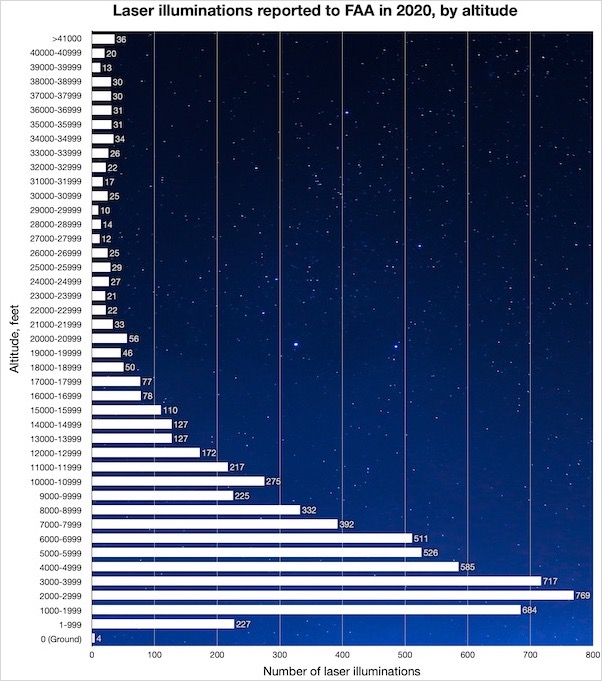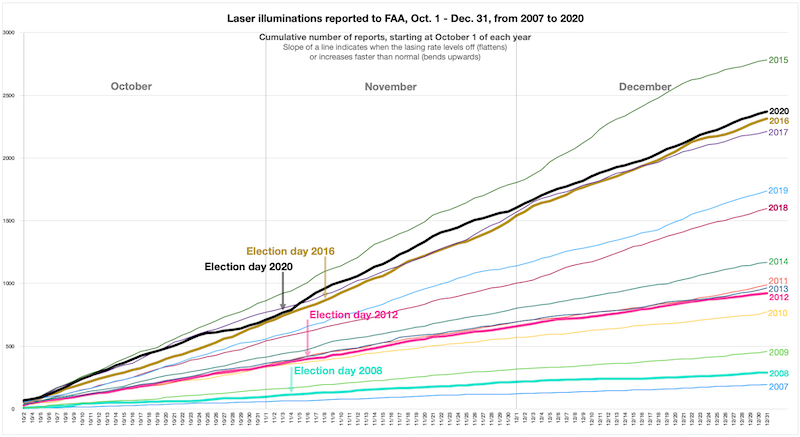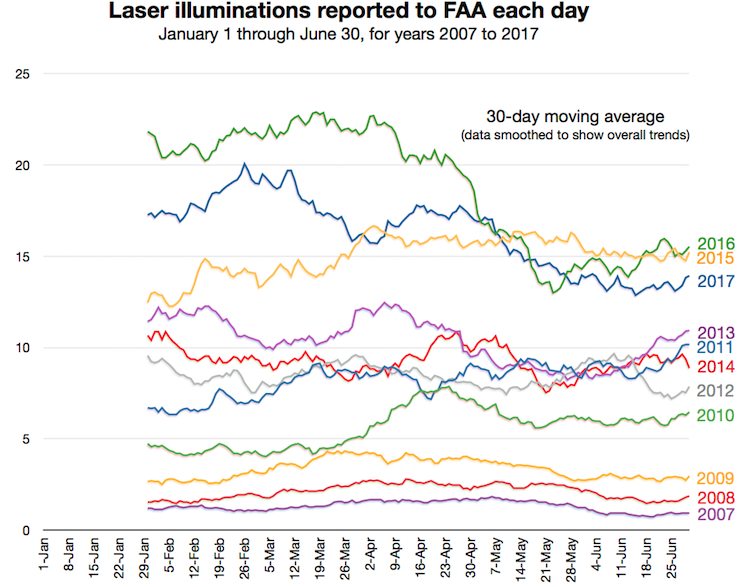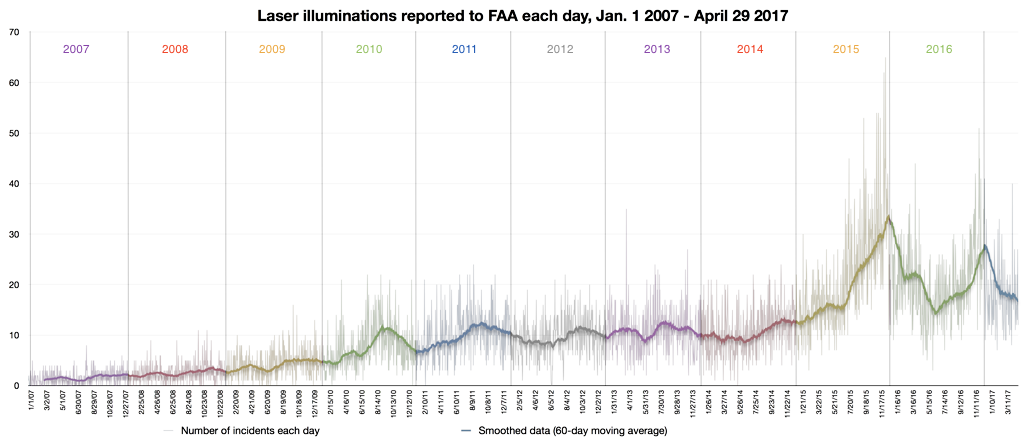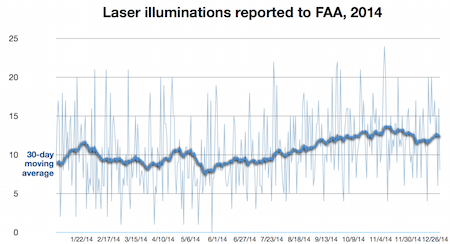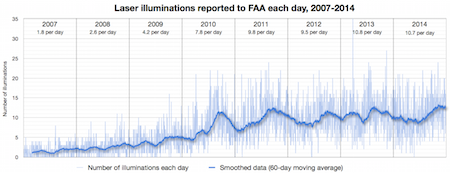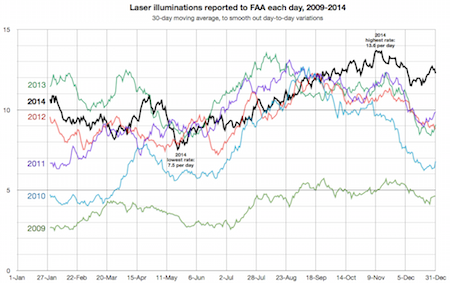Home
A comprehensive resource for safe and responsible laser use
US: GAO report says less than 1% of laser-aircraft incidents result in fines or prosecution
From July 2016 through September 2020, there were about 27,000 laser incidents reported by pilots to FAA.
Of these, 232 suspects were identified (0.86%). The "overwhelming majority… involved illumination of police and media aircraft", primarily helicopters that can hover over a scene. This hovering makes it much easier to identify perpetrators' locations, compared with fixed-wing aircraft that often cannot deviate from their route to chase after perpetrators.
FAA CIVIL ACTIONS
FAA took civil action against 99 of the 232 suspects:
• Assessed civil penalties against 70 of the 99 subjects. These civil penalties ranged from $50 to $27,338.29
• Proposed but had not assessed civil penalties against 17 of the 99 subjects.
• Ordered administrative actions (e.g. issuing warning notices to subjects) against three subjects
• Issued compliance actions (e.g. counseling) against eight subjects.
• Referred one case to the government of Canada for legal action because the subject was a Canadian resident.
This chart shows what happened to the remaining 133 suspects:
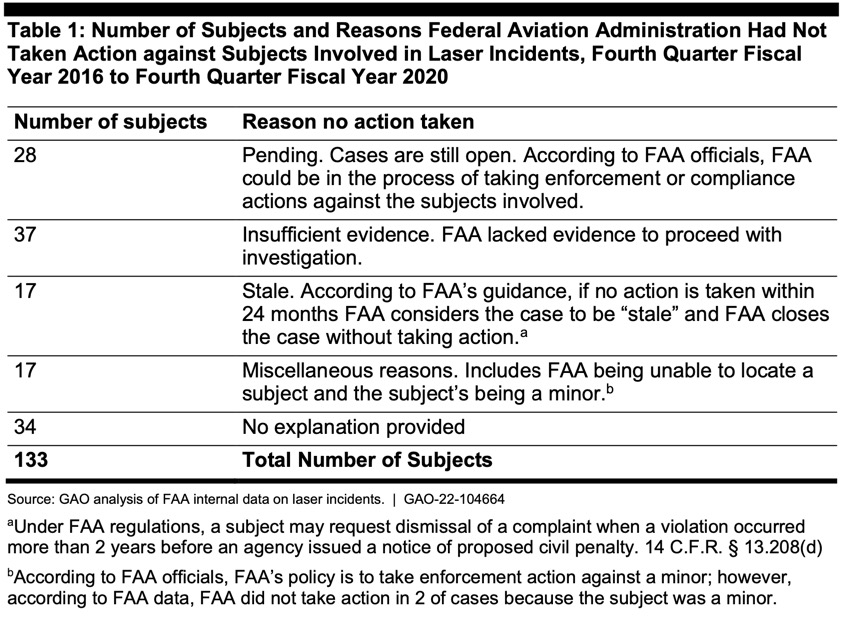
To summarize, out of 27,000 laser incidents there have been 70 persons fined so far (0.26%). There is the possibility of fining an additional 45 persons (17 proposed, 28 pending). If every one of these additional 45 persons was fined, that would make a total of 115 persons who would be fined (0.43%).
Thus, less than 1/2 of 1 percent of all laser incidents reported to FAA result in a fine or potential fine.
US ATTORNEYS' OFFICE CRIMINAL ACTIONS
In addition, there were criminal prosecutions. From the GAO report:
"According to our analysis, the FBI and other federal entities referred 86 laser incidents to USAOs for prosecution from July 2016 through September.32 Our analysis shows USAOs prosecuted 44 subjects, resulting in 40 convictions. In 23 of the 40 convictions, the subject received no term of imprisonment, while 15 subjects were sentenced to terms of imprisonment ranging from 3 months to 51 months."
"FBI officials told us federal prosecution may be more likely if a subject is suspected in a cluster of laser incidents, if a law enforcement aircraft was lased and a mission was interrupted, or if a subject had prior offenses, among other criteria."
Forty convictions out of 27,000 incidents is 0.15%. The 15 subjects imprisoned represent 0.06% of the incidents.
The report does not state if any of the criminal cases overlap with the FAA civil cases (e.g., a case is counted twice — once for FAA and once for criminal actions).
Data from the GAO's full 46-page report.
US: 9,723 illuminations reported to FAA during 2021
This means pilots saw lasers on average 26.6 times each day in 2021.
The chart above, and other detailed statistics, are on the Laser/aircraft illuminations statistics page. This includes data such as the following:
- The total number of U.S. laser/aircraft incidents since reporting to the FAA was mandated in 2004, is 71,435 as of Dec. 31, 2021.
- The total number of worldwide laser/aircraft incidents reported to authorities since 2004 is 102,104. Only eight countries are included in this cumulative total, and many of these do not have data for some years in the 2004-2021 time period, so the actual number of incidents is higher.
- Green laser light remains the most-reported. In 2021, 86.1% of incidents involved green light; blue was second with 8.8%. The number of blue lasers reported has, in general, increased over the past few years. For example, in 2016 only 2.9% of incidents involved blue laser light.
- In 2021, 0.5% of FAA-reported laser/aircraft incidents indicated that crew members suffered eye effects or temporary injuries. This rate has decreased since 2011, when 1.4% of incidents incurred eye effects or temporary injuries. The most-reported effects were flashblindness and/or afterimage; pain, burning or irritation; blurriness; and unspecified eye injuries.
US: FAA details fines since 2016 for laser strikes
Dickson noted that "if a person shines a laser at a plane, it can mean a fine of up to $11,000 for a single incident and up to $30,800 for multiple incidents."
He added, "Like many crimes, there is a need for education, outreach, and the cooperation from the public to address this safety risk. We encourage the public to report laser strikes to the FAA via our website or to your local law enforcement agency."
From the FAA video on YouTube
US: FAA webpage analyzes laser strike statistics
It includes graphs of yearly, monthly and daily laser event numbers, data on events by month and by day of the week, states ranked by raw numbers and on a per capita basis, injuries, and altitudes at which lasers were seen. By clicking on data points or sections of a chart, a box pops up with more precise information.
Here is the top part of the webpage as it appeared in September 2021:
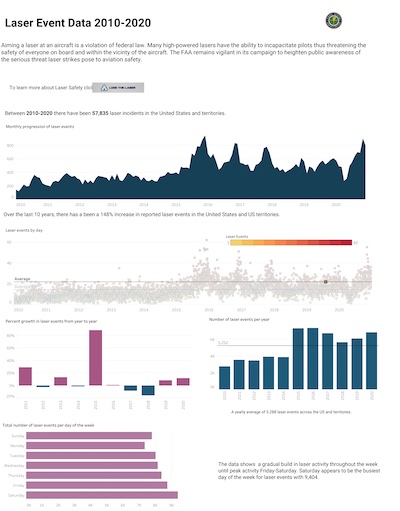
From FAA's data visualization webpage. If this link does not work, the data might also be accessed from FAA's main laser safety webpage. T
COMMENTARY FROM LASERPOINTERSAFETY.COM
Many of the FAA charts on the webpage are very interesting, such as the number of laser events per capita for each state. For example, Hawaii leads the country in laser illuminations per capita, in 2020.
However, some charts are near useless such as the "injuries" chart. This is organized by state, not by type of injury. Worse, there is no information provided about what counts as an injury, or the severity and outcome of the reported injury. (We have our own injury analysis chart on this page which is much more detailed.)
Another near-useless FAA chart is one that shows aircraft altitude during the incident. The chart shows data points with the number of flights at a given altitude. But there is no attempt to group altitude ranges together, for example, to find out how many laser incidents happened between 0-1000 ft, between 1000-2000 ft, etc. 
In contrast, this chart (done by LaserPointerSafety.com) has the same data formatted in a more understandable way:
Canada: 236 reported laser strikes in 2020
In Canada, a person who intentionally interferes with an aircraft by using a laser faces a prison sentences of up to five years, and a fine of up to $100,000.
From CBC News. Additional examples of 2020 Canadian laser illuminations are in the story.
NZ: Number of laser strikes on aircraft decreases, but may be due to flights decreasing
The March 2021 New Zealand data has been updated on the Laser/aircraft illumination statistics page. Scroll down to the "New Zealand" section. Also updated is the section comparing five countries including New Zealand.
The information was in a March 15 2021 email from CAA-NZ to LaserPointerSafety.com. The email noted that "Unfortunately our 2020 numbers were low primarily because our aircraft movements dropped so much due to Covid-19."
To look into this further, LaserPointerSafety.com estimated that in 2020 there were 273,000 airport movements (defined as a takeoff, landing or missed approach handled by Airways New Zealand). This compares with 1,023,000 movements in 2019 and a similar number in 2018.
Using this metric, in 2020 there were 256 laser illuminations per 1 million movements. This would be actually be a significant increase from the 2019 figure of 232 laser illuminations per 1 million movements.
Such a comparison may not be fully valid, however. The number of movements probably does not include flights by police and rescue aircraft. Because these are disproportionately targeted by laser perpetrators, a complete analysis would need to include such flights. It is not known if data are available.
Data from a March 15 2021 email from CAA-NZ. Thanks to Jenny Knowlsey for this data. Additional data on New Zealand aircraft movements is listed on the Laser/aircraft illumination statistics page under the "illuminations per 1 million flights" chart. Note that although "airport movements" are discussed above, on the statistics page this has been converted to "flights" by dividing the movements in half. This was done because "flights" is more understandable to the general public than "airport movements."
US: Why did lasers aimed at aircraft increase after the 2020 election?
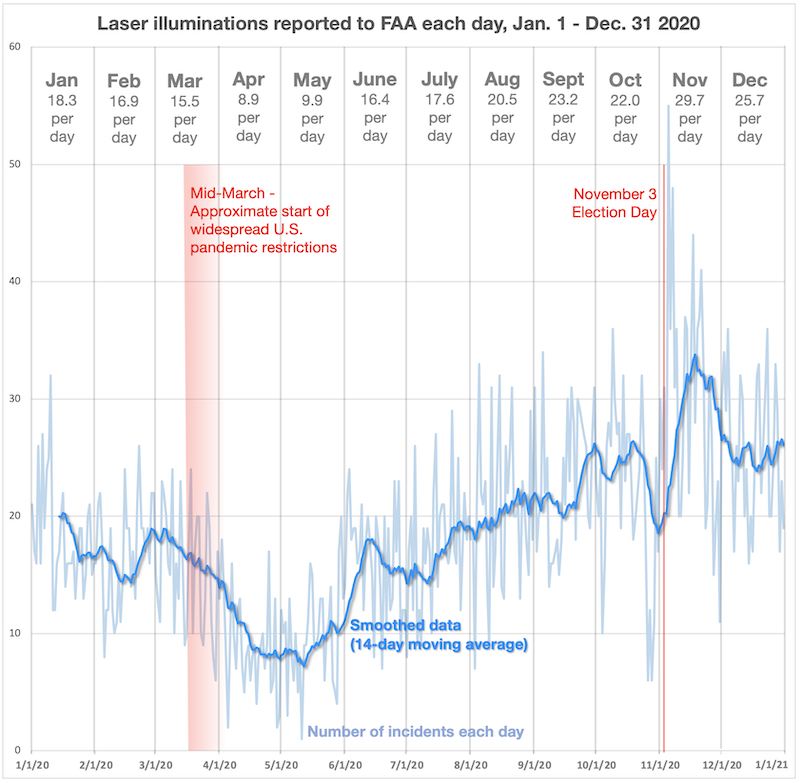
In fact, of the 10 highest days (most incidents) in 2020, all but one occurred in the Nov. 5-21 period. There were 55 incidents on Nov. 5, 48 on Nov. 6, 44 on Nov. 17, and 41 on Nov. 21. These occurred more than twice as often, compared with the 2020 average of 18.7 incidents per day.
Is this a statistical anomaly or did the disputed election results somehow lead to an increase in laser incidents?
COMMENTARY AND ANALYSIS BY LASERPOINTERSAFETY.COM
The chart below indicates that the three previous U.S. presidential elections did not have an effect on lasing incident rates.
It shows that in 2008, 2012, and 2016 the number of laser incidents each day between October 1 and Dec. 31 rose smoothly and steadily. In contrast, the lasing rate in 2020 (black line) slowed substantially around October 26, and rose significantly just after Election Day on November 3.
However, these two effects appear to counter each other. It may be that some other factor, such as how FAA records or processes laser incident reports, slowed in late October and sped back up in November.
In summary, while it is tempting to say that agitation over the 2020 election results led to an increase in persons aiming lasers at aircraft, this was not seen in previous election years and may be a statistical anomaly.
US: 6,852 laser illuminations reported to FAA in 2020
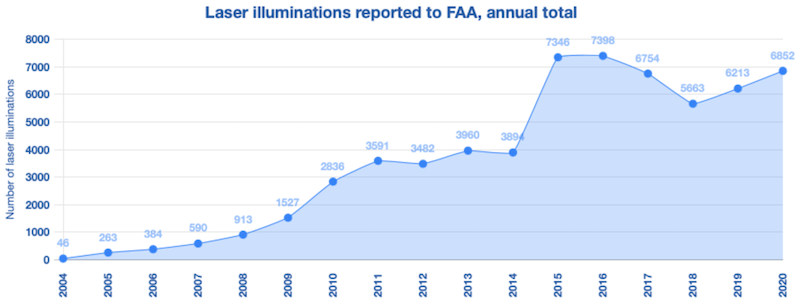
This means pilots saw lasers on average 18.7 times each day in 2020. However, the lasing rate was not evenly distributed. It reached a monthly low of about 9 illuminations per day in April 2020 — just as nationwide pandemic restrictions started. The highest rate was in November 2020, with almost 30 illuminations per day.

The peak number of illuminations, 55 on Nov. 5, occurred two days after the contentious 2020 election, when a presidential winner had not yet been declared. Of the 10 highest days (most incidents) in 2020, all but one occurred in the Nov. 5-21 period. A separate story at LaserPointerSafety.com discusses whether this is a coincidence or if there is some correlation with the election.
The charts above, and other detailed statistics, are on the Laser/aircraft illuminations statistics page. This includes data such as the following:
- The total number of U.S. laser/aircraft incidents since reporting to the FAA was mandated in 2004, is 61,712 as of Dec. 31, 2020.
- The total number of worldwide laser/aircraft incidents since 2004 is over 90,000. Only eight countries are included in this cumulative total, and many of these do not have data for some years in the 2004-2020 time period.
- Green laser light remains the most-reported. In 2020, 85.4% of incidents involved green light; blue was second with 9.2%. The number of blue lasers reported has steadily increased over the past few years. For example, in 2016 only 2.9% of incidents involved blue laser light.
- In 2020, only 0.3% of FAA-reported laser/aircraft incidents indicated that crew members suffered eye effects or temporary injuries. This rate has decreased since 2011, when 1.4% of incidents incurred eye effects or temporary injuries. The most-reported effects were flashblindness and/or afterimage; pain, burning or irritation; and blurriness.
Canada: Pilots want lasing aircraft to be a crime
Tim Perry made his proposals May 11 2020 after a Jazz Aviation pilot was hospitalized due to being illuminated by laser light on approach to Ottawa/Macdonald-Cartier International Airport, on February 15 2020. The laser source was about three nautical miles from the aircraft. The co-pilot of the de Havilland DHC-8-300 passenger aircraft had to turn control over to the captain, who was able to land without incident. The co-pilot was taken to hospital as a precaution due to actual or potential injuries. No additional information was made available by Jazz due to privacy restrictions.
Perry said that other Canadian aviators have actually suffered permanent retinal damage as a result of laser strikes, according to the National Post. Details on the Jazz pilot's condition, or on the other pilots — how many, degree of severity, eventual outcome — were not listed in the Post article. There were eye injury claims in February 2020 when an Ornge medical support aircraft was struck by a green laser in downtown Toronto, and an eye injury claim by a WestJet pilot flying from Newfoundland to Orlando in May 2019.
The article stated that "Most of the reports in the CADORS [aviation incident] database indicate that police were notified, but neither Transport Canada nor the RCMP [Royal Canadian Mounted Police] could cite an example of anyone in Canada ever being prosecuted." [Note: LaserPointerSafety.com has found at least four cases of Canadian prosecutions.]
Canada has previously taken steps to reduce laser/aircraft incidents. These may be having some effect, as laser incidents have been dropping from a reported high of 658 in 2015, to 274 in 2019, according to the National Post article.
On June 28 2018 Transport Minister Marc Garneau banned the use of hand-held lasers 1 milliwatt or more (the power of a small pet laser pointer) in Toronto, Montreal and Vancouver, and within 10 km of airports or heliports. There are exceptions for uses such as work, education, school or astronomy.
Any person with a battery-operated, handheld laser in a prohibited zone 1) outside of a private dwelling and 2) without a legitimate purpose can be fined immediately and “on the spot” up to CDN $5,000. A corporation violating the law can be fined up to CDN $25,000. The fines are in addition to any criminal prosecution; intentionally aiming a laser at an aircraft can result in five years in prison and/or up to CDN $100,000 in fines.
On May 24 2016, Garneau announced a social media awareness campaign. This included setting up a webpage in June 2015 that includes a catchy animated video, “Dumb Ways to Blind” aimed at millennials, plus three other more conventional videos on the topic. Transport Canada also tweeted using the hashtag "#NotABrightIdea".
Section 7.41(1) of Part I of the Canadian Aeronautics Act is a general prohibition against behavior that endangers aircraft. It provides a fine of up to CDN $100,000 and up to five years in prison for interfering with the duties of a crew member. This has been cited by Transport Canada as part of its webpages discouraging persons from aiming at aircraft.
From the National Post, March 11 2020. Note that there has been a discrepancy between newspaper reports of the number of annual laser/aircraft incidents, and Transport Canada figures. For more information, see the Canada section on the Laser/aircraft illumination statistics page. Thanks to Randy Paura for bringing this news to our attention.
US: 2019 laser incidents up almost 10% compared to 2018
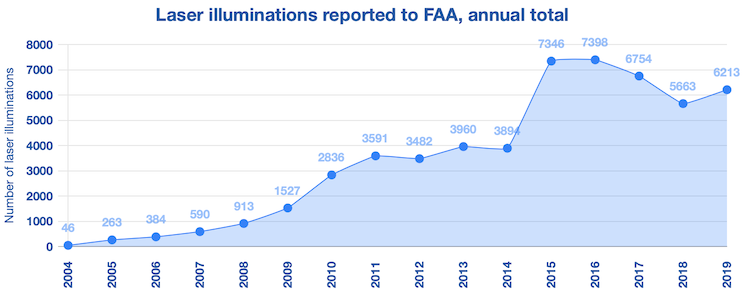
During 2019 there were 17 laser incidents reported each night in the U.S., on average.
This brings the 15-year total to 54,860 incidents since 2004 when FAA first started requiring pilots to report laser sightings or illuminations.
The majority of reports continue to involve green lasers (87.2% of 2019 reports). However, reports of blue lasers have risen steadily, from 2.9% in 2016 to 8.2% in 2019.
Holiday lights do not seem to be a significant problem. In 2019 there were only 11 reports (out of 6,213) involving Christmas or holiday laser light projections.
The number of incidents with reported eye effects or claimed injuries was 31 in 2019, a significant increase over the 23 reported in 2018. There were no serious or permanent injuries. The most-reported effect was being flashblinded and/or seeing spots. Six pilots had pain, burning or irritation in their eye. Only three pilots sought or considered seeking medical attention for their eye effects — the lowest number in the seven years analyzed by LaserPointerSafety.com (2011, 2012, and 2015-2019).
FOR MORE INFORMATION: Additional charts showing U.S. and other country laser illuminations, are on the Laser/aircraft illumination statistics page.
New Zealand: Government report on regulatory effectiveness in controlling laser pointers
The following is from the Conclusions section of the report:
"The Ministry’s implementation of the Health (High-power laser pointer) Regulations 2013 and the associated Customs Import Prohibition Order has continued smoothly. The work has not created a large burden for health officials and others involved.
Advertising of HPLPs on auction websites is increasing slowly. Advertising of HPLPs of a power far greater than that on the label continues to be a problem.
In the coming year, the Ministry will continue its surveillance of Trade Me and other websites, and will conduct further discussions with Trade Me on possible additional controls, especially for overseas sellers.
It is of continuing concern that numbers of laser strikes on aircraft continue to increase. [From 173 reported laser strikes in 2017, to 238 in 2018]
Countries vary in their approaches to managing the risks from HPLPs, from raising public awareness to calling for voluntary improvements in labelling. However, there is consistency in terms of the strong controls countries apply to address aircraft laser strikes, including bans and high penalties.
The Ministry will arrange to meet with other agencies, including the Ministries of Transport and Justice, the Civil Aviation Authority, New Zealand Customs and the New Zealand Police, to discuss potential additional controls in response to the increasing laser strike reports."
Use the "Click to read more…" link below to view selected text and statistics from the report, which is available online in Microsoft Word format and in PDF format. A summary is available from a news article at Stuff.co.nz, "Rising laser pointer sales spied on as health bosses are unhappy at aircraft attacks".
Click to read more...
Switzerland: Laser pointers above Class 1 banned as of June 1 2019
As of June 2019, this is the most restrictive laser pointer law of any major country; Class 2 pointers (up to 1 milliwatt) are legal in most countries, and Class 3R pointers (up to 5 milliwatts) are legal in the U.S.
Travelers should note that laser pointers and "hybrid devices" above Class 1 that are being transported into or through Switzerland can be confiscated before entering Swiss borders. For example, a wireless mouse used for PowerPoint presentations, such as the one shown below could be confiscated if it contains a laser above Class 1.
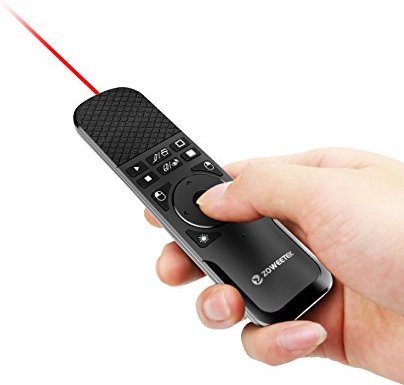
The Swiss ban applies to all laser classes above Class 1 (1M, 1C, 2, II, 2M, 3a, IIIa, 3R, 3B, IIIb, 4 and IV) as well as pointers with no labels or markings. These are all defined as "dangerous pointers" by the Swiss Federal Office of Public Health.
Persons in Switzerland who currently possess "dangerous pointers" except for Class 2 must cease to use them beginning on June 1 2019, and must dispose of them as electrical waste before June 1 2020.
Persons possessing Class 2 pointers can use them indoors only for presentations until June 1 2021, by which time they must be disposed of as electrical waste.
"Laser pointer" is defined as "a hand-held laser that can be used to point to things, for amusement (as a toy or in hobbies), to scare off animals or drive away other people."
More information appears below.
South Africa: 70+ laser incidents reported in 2018
In one case at at O.R. Tambo, Africa's busiest airport, "a commercial airliner on final approach to touchdown had to perform a go-around after a laser was directed at the eyes of the flight crew."
Two men in Bloemfontein were recently arrested for aiming lasers at helicopters. According to the story, "[a]s far as can be ascertained only one arrest has previously been made for shining a laser," which happened during the 2010 FIFA Soccer World Cup in Durban.
The New Age Online reported "Both the Civil Aviation Authority (CAA) and Airline Pilots Association of SA (ALPA) have spoken out strongly against the practice, which carries a maximum sentence of 30 years in jail…. ALPA general manager Sonia Ferreira said members were increasingly reporting incidents of 'sudden and intense bursts of light, deliberately shone at aircraft in and around airports'."
From the New Age. The article first appeared online May 14 2019.
US: FAA data shows lower numbers for 2015 and other years
The original, higher figure came from the December 31 2015 FAA Laser Report. This spreadsheet of laser incidents had 7,703 rows with each row listing one laser illumination report.
In January 2016, researcher Dr. Todd Curtis cleaned up the list and found 7,676 valid reports. (The clean-up criteria is not known.)
The FAA's new, lower number of 7,346 reports was first noticed by LaserPointerSafety.com in an April 10 2019 fact sheet released by FAA. The agency has a separate page with Microsoft Excel spreadsheets listing reported laser incidents for 2010 through 2018. The spreadsheet now online for 2015 has only 7,346 reports — not the 7,703 reports of the original December 31 2015 FAA spreadsheet.
LaserPointerSafety.com has analyzed some of the dropped reports. A few may be duplicates, but many appear to be valid reports dropped for an unknown reason.
LaserPointerSafety.com believes that the original 7,703 figure is closer to the actual number of laser illumination reports submitted by pilots in 2015. However, for consistency, as of May 5 2019, LaserPointerSafety.com is using the new April 2019 FAA numbers on various pages such as the Laser/aircraft illumination statistics page.
Note that there may be some website pages and some articles, scientific papers, etc. outside of the website which reference the original, pre-April 2019 numbers.
Changed numbers also for 2007, 2008, 2016 and 2017
The number of laser incidents reported in other years has also changed:
- 2007 was originally listed as having 639 reports; in April 2019 FAA said there were 590 reports.
- 2008 was originally listed as having 949 reports; in April 2019 FAA said there were 913 reports.
- 2016 was originally listed as having 7,442 reports; in April 2019 FAA said there were 7,398 reports.
- 2017 was originally listed as having 6,753 reports; in April 2019 FAA said there were 6,754 reports.
US: FAA credits "heightened public awareness" for lowering laser incident numbers in 2017 and 2018
Incidents reported to FAA have declined from 7,398 reports in 2016, to 6,754 reports in 2017, and 5,663 reports in 2018, the last full year for which statistics are available.
According to FAA, "the agency and law enforcement agencies are working hard to increase public awareness of the dangers posed by lasers."
The news item linked to a page entitled "Laser Incidents and Legal Interpretation of the Law", a new video published April 10 2019 on YouTube, entitled "Laser Strikes on Aircraft Pilots", and an April 10 2019 Fact Sheet on lasers.
One paragraph of the fact sheet says that "The FAA’s guidance for agency investigators and attorneys stresses that laser violations should not be addressed through warning notices or counseling. The agency seeks moderately high civil penalties for inadvertent violations, but maximum penalties for deliberate violations. Violators who are pilots or mechanics face revocation of their FAA certificate, as well as civil penalties."
From FAA news item "Outreach Helps Bring Laser Strike Numbers Down"
COMMENTARY FROM LASERPOINTERSAFETY.COM:
We are not aware of any recent (2015-2018) campaign by FAA to increase public awareness.
In 2014, there was a publicity campaign by the Federal Bureau of Investigation (FBI) in 12 U.S. cities between February 11 and April 11 2014, which offered a $10,000 reward for information about anyone pointing a laser at an aircraft. This was expanded nationwide between June 3 and September 1 2014. During 2014 there was a 12.8% decline in laser incidents compared to 2013. It is not known how much the FBI publicity campaign contributed to the decline.
In our view, there may be other reasons for the decline. For example, pilots may be tiring of reporting laser illuminations with no apparent follow-up or effect. This would lead to a decline in reported incidents.
We are not aware of any studies done to determine the reasons for declines in reported laser incidents.
To summarize, it seems incorrect to attribute the lower number of laser incidents to "heightened public awareness." In fact, there is some anecdotal evidence that publicity actually leads to copycat laser incidents.
UK: 200+ laser pen injuries illustrate the risk to children, especially with behavioral problems
The study looked at 77 case reports of laser eye injuries in children. In four of the cases there were reported psychological or behavioral issues.
In addition, the authors had experience with four children with laser eye injuries; in three of these cases there were psychological or behavioral issues.
One of the authors sent a survey to 990 consulting ophthalmologists in the U.K. This found 159 cases of macular injury due to "misuse of a handheld laser device," with 80% of those injured being children or teenagers. In 35% of the cases, the injury was self-inflicted; in 36% it was caused by a third-party. (The remaining 29% seem to be uncategorized although the paper notes that "there were no cases of assault reported." In 67% of the cases where the laser power was known, it was under 50 milliwatts.
The paper cautions that the actual number of laser injuries seen by the ophthalmologists may be higher: "A limitation was the poor response rate and thus data so obtained do not provide the true incidence and clinical features of such cases."
Click to read more...
New Zealand: Pilots, legislator want total ban on handheld lasers over 1 mW
The bill would double penalties for violations from the current 3 months imprisonment or $2000 fine, to 6 months or $4000. And it amends the Crimes Act 1961 to make explicit that interference with a transport facility includes using a high-power laser pointer to reduce the ability of aircraft crew to perform their duties.
The High-power Laser Pointer Offences and Penalties Bill was introduced September 6 2018 by Clutha-Southland MP Hamish Walker.
The president of the New Zealand Airline Pilots Association said "We are asking for a prohibition primarily because the risk outweighs markedly, any utility they are having in society. We don't believe they need to be in the country there is plenty of other alternatives as we are calling for a complete prohibition."
In Wellington in August 2018, a $20 million control tower was opened. On its first day of operation, several staffers reported a laser being aimed in their eyes. Some had to lie down after experiencing nausea.
A police database of incidents found 311 reports in 2018 using the keyword "laser."
From the High-power Laser Pointer Offences and Penalties Bill and NewstalkNB.
Canada: Study first to show prevalence of laser use, injuries among general public
It showed that 48 percent of Canadians over the age of 12 either used or were exposed to lasers, annually.
Of those who reported using a laser product, 1.1% reported discomfort or injury.
[LaserPointerSafety.com analysis: Based on 2016 Canadian census data, there were 29,312,165 Canadians age 15 or older — data was not available on age 12+. If 48% of these 29 million Canadians used or were exposed to lasers, that would be just over 14 million people. If 1.1% of them experienced discomfort or injury, that would be about 155,000 Canadians with laser discomfort or injury.]
Returning to the Statistics Canada study, of the discomfort/injury cases:
- 41% were for skin injuries "such as rash, itch or pain," while 59% were for eye injuries "such as itchiness, pain, visible floating objects, blurred vision, burn, flash blindness, excessive watering or loss of sight."
- In 64% of cases, the discomfort or injury lasted less than two days; in 34%, it lasted more than two days.
- The discomfort/injury was caused by the person's own use of the laser in 25% of cases, and by someone else's use in 75% of cases.
- 39% of the discomfort/injury cases were caused by cosmetic treatments, 26% were caused due to laser pointers, and 34% were caused by "other" which included surveying tools, entertainment lasers, materials processing, and scanners.
The study analyzed published eye injury case reports since 1999, and concluded:
"…the majority involved the misuse of a handheld battery-operated laser product by an adult or a child. Most of these injuries were the result of irresponsible use or deliberate staring at a laser by a child, or the result of the inappropriate use of a high-powered laser device (Class 3B or 4) in an 'uncontrolled environment'....In the cases reported in 2014 that included long-term follow-up injury reporting, about one-half of the ocular injuries resolved within one to two weeks, with the other 50% of patients sustaining longer-term visual impairments."
Click to read more...
Germany: Laser/aircraft incidents decline 12.4% compared to last year
This decrease is despite a doubling of incidents at Frankfurt International Airport. In the first half of 2018 there were 22 laser illuminations versus only 11 during the same period in 2017.
Declines were reported at Munich, Hamburg and Stuttgart airports.
A spokesperson for the German pilots' union Vereinigung Cockpit seemed to indicate that increasing prosecutions were a cause of the drop from 2017 to 2018: "A few years ago, the laser attack was a hip prank for some young people. The perpetrators must now be aware that they are consistently prosecuted."
From DW.com reporting on a story from public broadcast service ARD. Thanks to Greg Makhov for bringing this to our attention.
UK: Average of 50 laser illuminations of military aircraft per year in UK
It is not clear if these military incidents are included in the Civil Aviation Authority (CAA) statistics about laser illuminations of aircraft.
The Ministry of Defence figures, made public June 11 2018, were rounded to the nearest 10. The list below shows the reported military-related laser incidents in the UK, along with the CAA numbers for the UK and for overseas UK operators
2013 - 40 military, 1396 CAA UK home, 329 CAA UK overseas operators
2014 - 70 military, 1447 CAA UK home, 317 CAA UK overseas operators
2015 - 70 military, 1440 CAA UK home, 355 CAA UK overseas operators
2016 - 30 military, 1258 CAA UK home, 274 CAA UK overseas operators
2017 - 40 military, 989 CAA UK home, 243 CAA UK overseas operators
The information was released in response to a written parliamentary question submitted by former defence minister Kevan Jones, who said “New laws to deter those stupid enough to carry out these attacks might not be enough, and the Government should give police operating around air bases the resources needed to catch offenders.”
From the Mirror. We have additional statistics and stories about the UK, plus a page with statistics about the UK and other countries.
UK: New UK law provides stronger penalties, easier prosecution for aiming a laser at a vehicle
The penalties for violations are up to five years imprisonment and an unlimited fine; these penalties take effect starting July 10 2018.
The law applies to laser beams aimed at aircraft, motor vehicles, trains, ships, hovercraft and other vehicles. A vehicle does not have to be moving at the time of offense; if the engine or motor is running then the law applies. Another provision makes it an offense to shine or direct a laser beam towards an air traffic facility, or a person providing air traffic services, under the condition where the beam dazzles or distracts, or is likely to dazzle or distract a person providing air traffic services.
The offense is a strict liability offense, meaning that prosecutors do not need to prove that the person shining the laser intended to endanger the vehicle or air traffic facility/controller. There are two defenses allowed: 1) the person had a reasonable excuse for shining the laser beam, or 2) the person did not intend to shine a laser at the vehicle/ATF/controller and exercised all due diligence to avoid doing so.
Click to read more...
UK: NPAS says only 1.4% of laser perpetrators were prosecuted
James Cunningham told Police Oracle in a March 21 2018 article that there were a number of reasons for the low prosecution rate, including being not being able to follow the laser perpetrator due to being focused on another job (e.g., completing the original mission).
Also, when lasers are pointed from a tower block area, the helicopter crew may not be able to locate the source.
In 2017 there were 67 incidents [not clear if this is NPAS only], compared with 70 in 2016 and 103 in 2015. Cunningham said the reduction is because NPAS is trying to locate and pursue laser perpetrators, and report the incidents as crime. He said the Laser Misuse (Vehicles) Bill being considered in Parliament is a “step in the right” direction that could lead to more prosecutions.
In December 2017, NPAS purchased laser-reducing glasses which can enable pilots to continue even when illuminated by laser light.
From Police Oracle
Canada: Looking at "all possible options" to fight laser incidents; perhaps a ban and mandatory labels
The statement came after six laser incidents over two days earlier in the month, at Montreal’s Trudeau Airport. Garneau said these made him “very, very mad.”
A Transport official said the options include a ban on importation of powerful lasers, mandatory warning labels, and stronger penalties for those who are caught.
Garneau noted that it is hard to catch a laser perpetrator, making prosecutions “few and far between”. He believes that some people are not aware of the bright-light danger of laser light, but that others “know darn well what they’re doing” and are trying to “provoke something.”
Transport Canada currently has a program called “Not-a-Bright-Idea,” trying to educate the general public about the risks and legal consequences of aiming lasers at aircraft. Since implementing the program in May 2016, laser incident numbers have dropped. There were 590 reported incidents in 2015, 527 in 2016, and 379 in 2017.
Garneau said that despite the 28 percent drop, Transport Canada must do more, and that is why they are exploring other options.
From 660 News and AVweb
Note: In response to a LaserPointerSafety.com request, an email address for interested persons was provided: “Transport Canada is exploring options to reduce laser strikes. Canadians and industry members can provide information to the Civil Aviation Communications Centre by emailing: services@tc.gc.ca”
Germany: Scientific study of laser pointer eye injuries finds 111 cases
Background: Recent years have seen a marked increase in laser-pointer-related injuries, which sometimes involve severe retinal damage and irreversible visual impairment. These injuries are often caused by untested or incorrectly classified devices that are freely available over the Internet.
Methods: We reviewed pertinent publications retrieved by a systematic search in the PubMed and Web of Science databases and present our own series of clinical cases.
Results: We identified 48 publications describing a total of 111 patients in whom both acute and permanent damage due to laser pointers was documented. The spectrum of damage ranged from focal photoreceptor defects to macular foramina and retinal hemorrhages associated with loss of visual acuity and central scotoma. On initial presentation, the best corrected visual acuity (BCVA) was less than 20/40 (Snellen equivalent) in 55% of the affected eyes and 20/20 or better in 9% of the affected eyes. Treatment options after laser-pointer-induced ocular trauma are limited. Macular foramina and extensive hemorrhages can be treated surgically. In our series of 7 cases, we documented impaired visual acuity, central visual field defects, circumscribed and sometimes complex changes of retinal reflectivity, and intraretinal fluid. Over time, visual acuity tended to improve, and scotoma subjectively decreased in size.
Conclusion: Laser pointers can cause persistent retinal damage and visual impairment. In view of the practically unimpeded access to laser pointers (even high-performance ones) over the Internet, society at large now needs to be more aware of the danger posed by these devices, particularly to children and adolescents.
From Birtel J, Harmening WM, Krohne TU, Holz FG, Charbel Issa P, Herrmann P. Retinal injury following laser pointer exposure—a systematic review and case series. Dtsch Arztebl Int, 2017 DOI: 10.3238/arztebl.2017.0831. Original in German, translation in English.
US: UPDATED - 6,753 laser/aircraft incidents reported to FAA in 2017; 9% lower than 2016
During 2017, there were 6,753 laser illumination incidents reported to the U.S. Federal Aviation Administration. This compares with 7,442 reports in 2016, and 7,703 reports in 2015. This is a 9% drop compared with 2016, and a 12% drop compared with 2015.
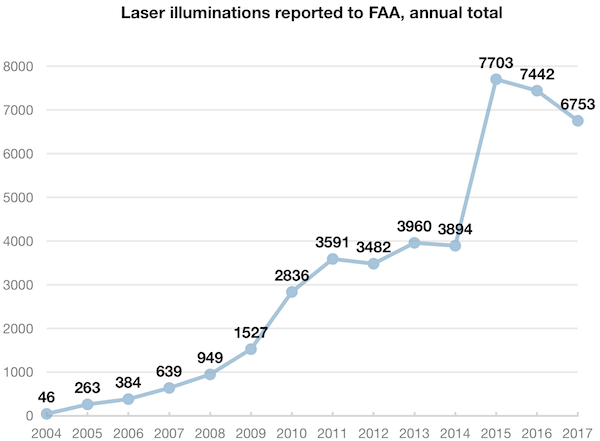
Here is the same data, plotted to show the average number of illuminations per day, during each year:
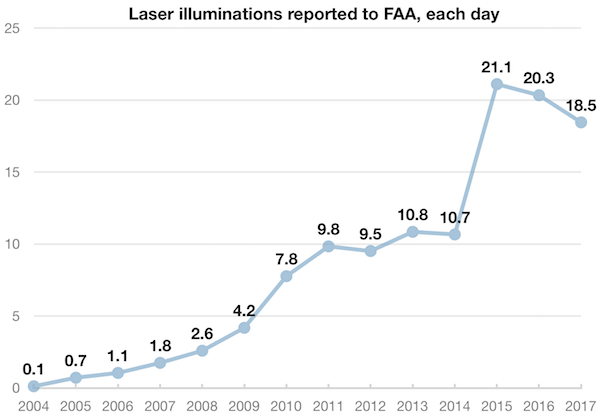
For additional charts and statistics, click the “read more” link.
UK: Laser pen imports to be more restrictive
In addition, “new measures are also being introduced to tackle the sale of unsafe pointers, including more stringent testing.”
The move was supported by the British Air Line Pilots Association (BALPA).
It may help reduce the number of laser pen illuminations of trains (578 incidents were reported between April 2011 and November 2017) and eye injuries (more than 150 reported since 2013, mainly involving children).
Consumer Minister Margot James said the ministry is “going further than ever before” to police the sale of unsafe lasers.
The Argus quoted Professor John O’Hagan, of Public Health England’s laser and optical radiation dosimetry group.He said: “Over time we have become increasingly concerned about the dangers of growing numbers of unlabelled and incorrectly labelled high power laser pointers being bought by the public. It is tragic that we continue to see eye injuries, especially in children. Laser safety experts at Public Health England have worked closely with local authorities in stopping large numbers of these lasers reaching UK consumers. The extra protections proposed should help even further - if you have a laser and you don’t need it, remove the batteries and get rid of it.”
From The Telegraph and The Argus. The stories seem to be a result of the U.K. government publishing, on January 8 2018, a response to their fall 2017 Call for Evidence. The government response included the increased import enforcement actions.
See also the December 2017 news of a new U.K. law that provides stronger penalties for aiming at aircraft. The new import/consumer initiative seems to be part of the government thrust against illegal and overpowered laser pens.
New Zealand: Laser pointer/aircraft incidents increase about 11% in 2017
If this rate of 14 incidents per month holds for December, the 2017 total will be around 169. This would be an 11% increase over 2016.
The information comes from the Civil Aviation Authority which noted that most incidents occurred in metropolitan centers. The CAA deputy director of air transport and air worthiness, Mark Hughes, warned "People are not aware of the significance of it. It's sort of a lark, or a fun thing to do, not recognizing that actually they're causing a real safety issue and creating a danger for pilots and passengers…. It could cause an accident if the pilot is visually impaired at a critical phase of the flight.”
From Radio New Zealand
UK: Government asks for ways to crack down on laser misuse; deadline is October 6
The government is concerned both with hazards from aiming laser pointers at pilots, drivers and train operators, and the potential for retinal damage among consumers when high-powered lasers are aimed into eyes.
They opened a consultation asking for suggestions for eight weeks, starting August 12 and closing at 11:45 pm on October 6 2017. A 23-page Call For Evidence PDF document is posted at the open consultation webpage. It includes background information on laser hazards and misuse.
There are 19 specific questions asked by the government, plus it is possible to respond with free-form text. Persons can respond via an online survey, by postal mail, or by sending an email.
The full text of the government’s press release is below.
From the UK government press release “Government crackdown on misuse of laser pointers”, the open consultation “Laser pointers: Call for evidence” webpage, and the call for evidence online survey webpage.
Click to read more...
US: UPDATED - 2017 laser incidents on pace to be lower than 2016
As of June 30 2017, there were 2,933 laser illuminations of aircraft reported to the U.S. Federal Aviation Administration. This is 15% fewer than the 3,441 illuminations reported as of June 30 last year (2016).
The chart below shows cumulative laser illuminations for the period Jan. 1 - June 30, for each of the past 10 years. The blue 2017 line shows that thus far there have been fewer incidents in 2017 than in 2016, but more than in 2015.
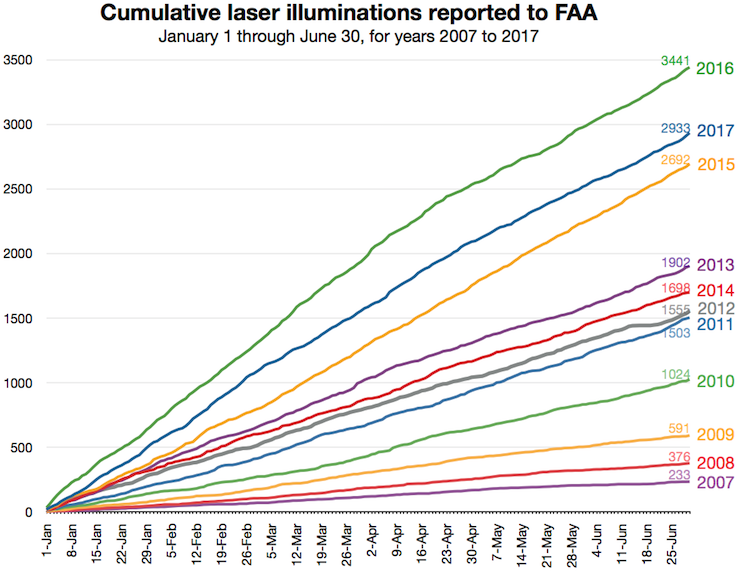
How to read this chart: Each year starts with 0 illumination reports. Each colored line then plots the cumulative (year-to-date) illumination reports for that year since January 1. For example, looking at the 2016 top green line, there were about 1000 reports between Jan. 1 and Feb. 12 (where the green 2016 line crosses the 1000 horizontal line). In contrast, in 2013 (purple line) there were roughly 500 reports between Jan. 1 and Feb. 12 (where the purple 2013 line crosses the 500 horizontal line).
Based on historical data, LaserPointerSafety.com projects that there will be around 7,200 laser illuminations reported to the FAA in 2017. This would be about 4% lower than the 7,442 reports in 2016, and about 7% lower than the 7,703 reports in 2015.
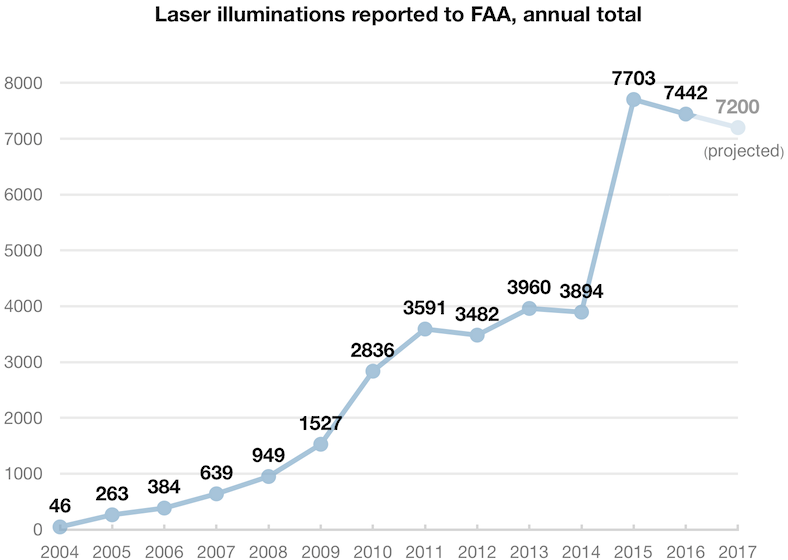
The next chart shows the number of laser illuminations per day. Each line is a different year. The lines have been smoothed by averaging the previous 30 days (a 30-day moving average). For this reason, the lines do not start until January 30.
This shows trends within a year. For example, in both 2016 and 2017 the number of reports dropped significantly in early May, while in 2015 the number of reports was more constant during that period.
The chart below shows the number of laser illuminations for every single day between Jan. 1 2007 and April 29 2017. The light spiky line shows each day’s illumination reports. This number can vary widely from one day to the next. The dark line is a 60-day moving average. This helps smooth out the data, in order to show longer-term trends.
From these charts, it can be seen that illumination reports grew slowly, or even declined, in the first few months of 2015, 2016 and 2017. However, in the final months of 2015 and 2016, the number of illumination reports picked up significantly. The estimate above (that there will probably be around 7,200 reports in 2017) takes this effect into account.
Statistical note: The careful reader will see that the blue 2017 line in the first chart falls between the 2016 and 2015 lines. Yet LaserPointerSafety.com predicts 2017 as a whole (Jan-Dec) will be lower than both 2016 and 2015. This is because we used all ten years, 2007-2016, to estimate the year-end total as a proportion of the first six months. Both a simple average of these ten years, and a weighted average — where more recent years have a larger effect — indicate that the 2017 total will be in the ballpark of 7,200 illuminations. In other words, 2015 was an atypical year where illuminations in the last eight months of the year grew much faster than any other year.
Taiwan: CAA considering restrictions after 8 laser incidents in first six months of 2017
In previous years the Air Navigation and Weather Service had 4-5 reports per year of laser interference. As of late June 2017, there had been 8 reports.
The most recent incident happened June 21 2017, when China Airlines flight 163 was landing at Taoyuan International Airport. Laser beams were coming from near to the runway. The pilot “requested that the interference be moved, after which the flight landed safely.”
From the Taipei Times
UK: 1,258 laser/aircraft incidents in 2016, a 12.6% drop from 2015
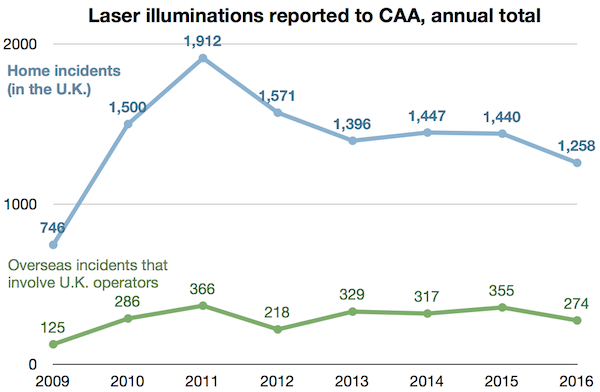
Note: Previous stories and charts elsewhere on LaserPointerSafety.com may have slightly different figures for some years. This is due to CAA updating numbers after a “SDD Coding Backlog”. The numbers above are all as reported in February 2017 by CAA.
The 1,258 home incidents in 2016 represent a 12.6% decrease from the 1,440 home incidents that occurred in 2015.
Similarly, the 274 overseas incidents in 2016 represent a 22.8% decrease from the 355 overseas incidents that occurred in 2015.
Here are the 1,258 home incidents in 2016, month-by-month:
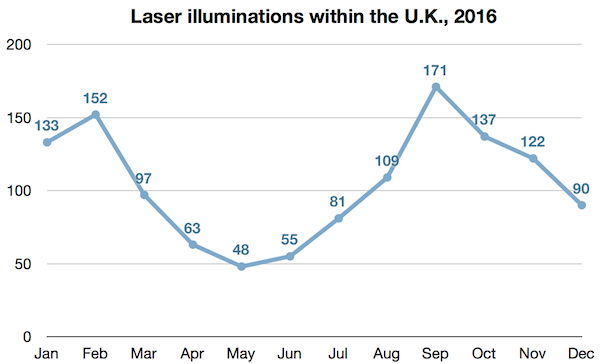
CAA listed the top 10 locations reporting laser incidents for 2016. It is not known whether these incidents all occurred at or near the indicated airports, or whether this also includes incidents (such as helicopter strikes) that occurred elsewhere but which were tallied to the closest airport.
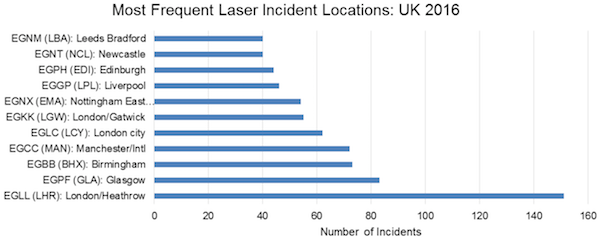
As in the United States, the majority of laser illuminations were reported to be green. The figures below are for U.K. incidents; the color distribution is roughly the same for overseas incidents as well.
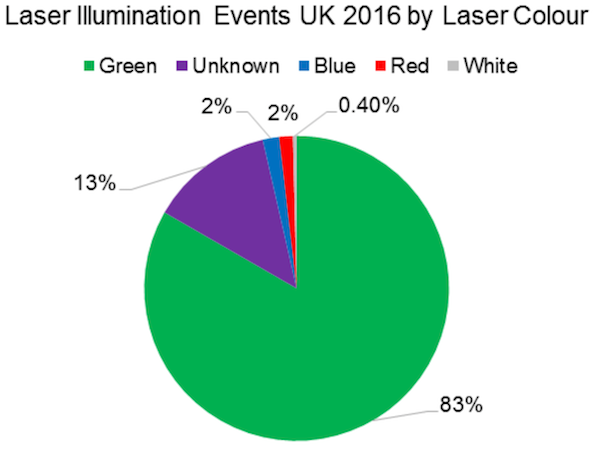
From a February 2017 report by the Civil Aviation Authority. This report contains additional details such as a monthly breakdown for each year 2009-2016, and for each of the top 10 home and overseas locations in 2016.
UK: New law proposes prison for aiming laser pens at aircraft, trains, cars, other vehicles
It is more stringent than the current law which 1) only applies to aiming at aircraft, 2) requires prosecutors to prove that the perpetrator endangered the aircraft and 3) has a fine of up to £2,500 (USD $3,112).
The new law will 1) apply to a wider variety of transport modes including automobiles, 2) require prosecutors only to prove that the laser was directed towards the transport vehicle and 3) will also add the prospect of prison time to the potential punishment. The exact new fines and prison terms were not stated in the DfT announcement.
Click to read more...
US: Study shows FAA-reported eye effects or injuries for four recent years
The data shows that pilots reported eye effects or injuries in less than 1% of laser illumination incidents. Flashblindness was the most-reported effect, followed by “Pain, burning or irritation in eye.” Blurriness was also frequently listed, along with unspecified “eye injury.”
In 20% of eye effect/injury cases, the person affected sought medical attention.
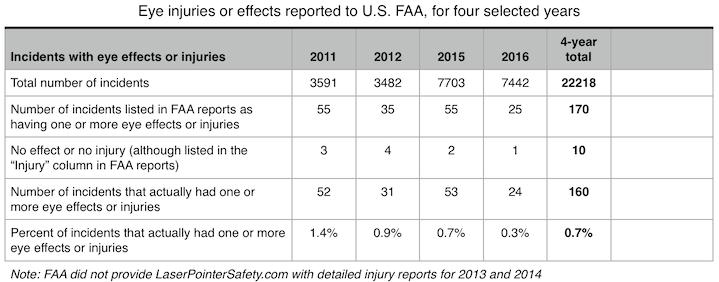
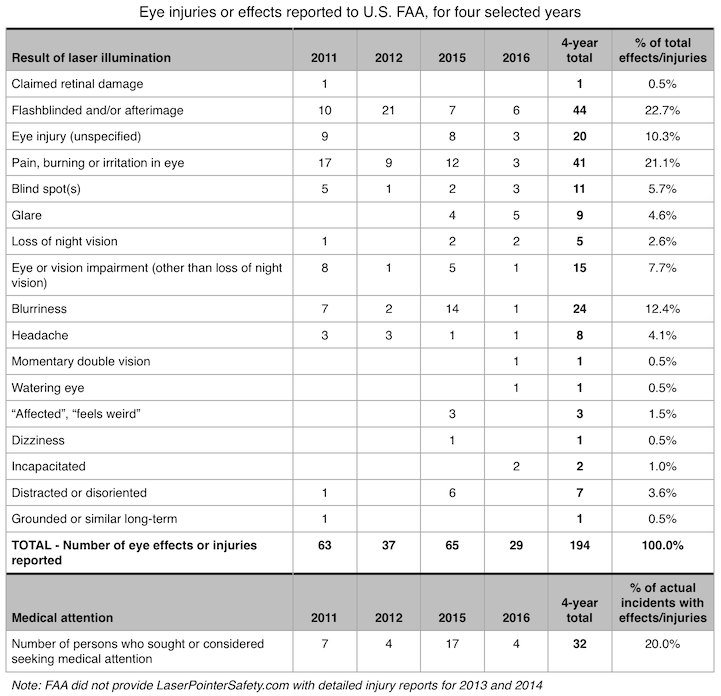
From the FAA weekly Laser Report
US: UPDATED - 7,442 laser incidents in 2016; slight decrease compared to 2015
According to FAA data, there were 7,442 laser illuminations reported by pilots in 2016. This is a slight decrease of 3.5%, compared to 2015. However, both 2015 and 2016 had far more incidents than the previous four years, 2011-2014.
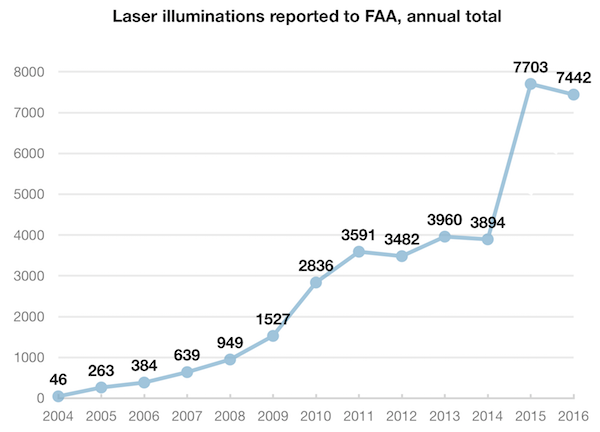
Here is the same data, arranged to show the average number of incidents per day:
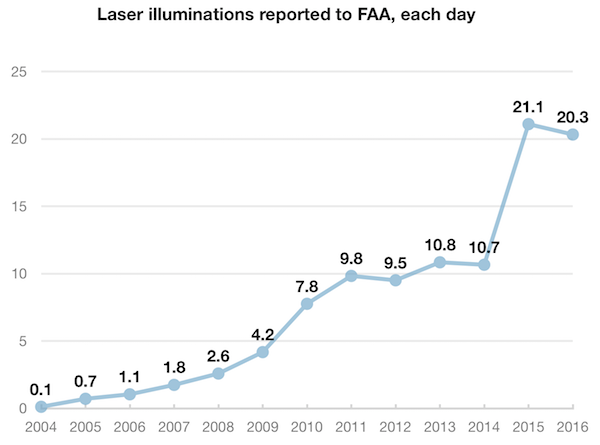
Laser color(s)
As in previous years, green was by far the most-reported color:
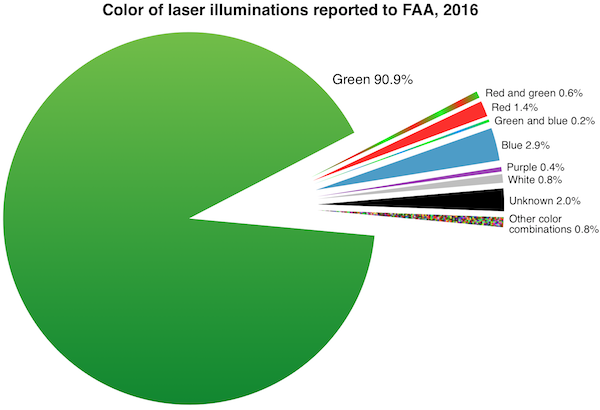
An October 2016 U.S. Food and Drug Administration proposal would allow the manufacture of laser pointers only in the 610-710 nanometer wavelength (orange-red to deep red). This chart shows the 2016 laser illuminations arranged according to those colors:
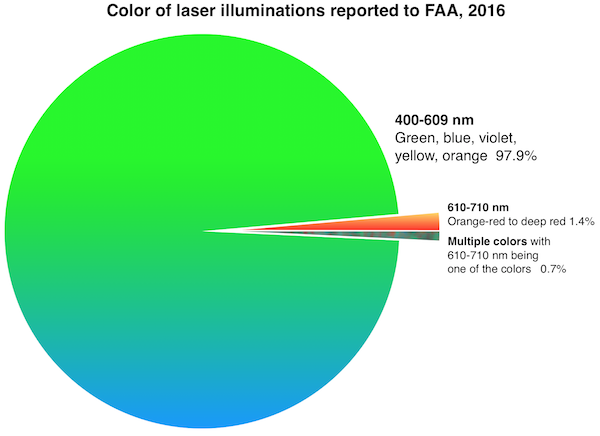
Eye injuries or effects
There were 24 laser illumination incidents in 2016 where eye effects or injuries were listed. This is 0.32% of the total number of incidents. These are the effects listed; the total adds up to more than 24 due to multiple effects in some cases.
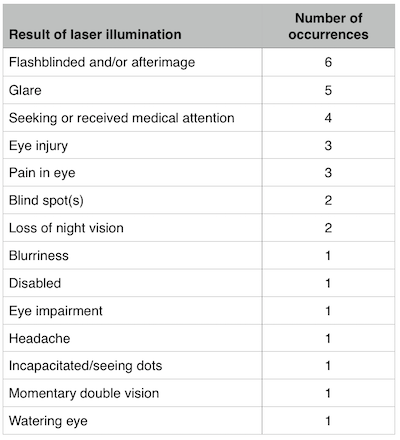
From the FAA weekly Laser Report, January 9 2017 with data January 1 - December 31 2016
Portugal: Irish investigators ask Portugal to make aiming lasers at aircraft illegal
This was the sole recommendation resulting from a September 5 2015 incident when the two pilots in a Ryanair flight, on approach to Porto Airport, were illuminated by laser light. The pilot flying was distracted and had to use his hand to shield his eyes. The pilot monitoring had temporary flash blindness lasting a few seconds. This contributed to the aircraft’s approach being “unstable.” The pilots executed a missed approach and did a go-around for a second approach; the plane then landed safely.
Portuguese officials told the Irish investigators that there is no law in Portugal against aiming a laser at an aircraft.
In 2014, there were 294 laser incidents reported in Portugal; in 2015 there were 264 such incidents. In 2014, 107 of the incidents occurred at Porto Airport; in 2015 there were 105 incidents at the airport.
From the Irish Examiner
Northern Ireland: "Laser Lunacy" drama visits schools to warn students not to aim lasers at aircraft
According to an October 19 2016 story in the Irish News, the performance depicts an aircraft crew member being blinded, which leads to a crash that injures 17 people. The subsequent investigation highlights how a criminal conviction can ruin a young person’s life.
After the performance there is a question-and-answer session to reinforce the message.
BIA’s Jaclyn Coulter told the newspaper “We have a very serious message to get across to young people and we thought that the most effective way of doing that was through drama…. [W]e are delighted with the response we have had both from schools and pupils. We want this practice to be stamped out. It is not fun. It is not a game.”
There were 35 aircraft illumination incidents last year, and 16 thus far in 2016.
From the Irish News
UK: Statistics on police helicopter laser attacks; one has been struck 100 times "over the last year"
Assuming “over the past year” means “in the last 12 months”, that would be an average of about two laser illuminations per week.
A separate article from BBC News states that in 2015 there were 91 reported laser illuminations of National Police Air Service aircraft. The largest number was 20 attacks against NPAS helicopters taking off from its Carr Gate headquarters near Wakefield, West Yorkshire.”
Reasons for the apparent discrepancy in numbers are not clear. It may be that South Yorkshire is not a member of the NPAS, which provides centralized air support to local police forces.
The BBC News chart below shows the 2015 NPAS laser attacks:
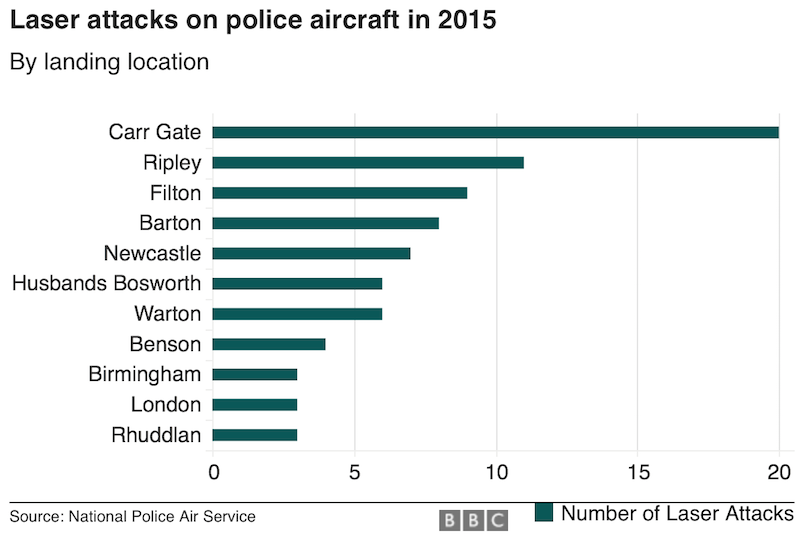
The NPAS is testing laser protective eyewear, as a means to help protect flight crews.
From The Star and BBC News. Interestingly, a September 14 search of the South Yorkshire Police website, to find more information about these incidents and police concern regarding lasers, did not find any results when searching for the term “laser.”
UK: BALPA calls for high-powered lasers to be treated as offensive weapons
BALPA noted that there were 1,439 reports of laser attacks in 2015, and that 55% of pilots experienced a laser attack in the past 12 months. A spokesperson said BALPA “has been campaigning for a long time for high-powered lasers to be treated as what they are — offensive weapons.”
The association was also concerned with the threat of incidents involving drones.
A motion to ask for improved regulations passed at the meeting.
From a BALPA press release
Ireland: Laser incidents decline over past two years
In 2014 the State Airports (Shannon Group) Act made it illegal to aim laser pens at aircraft. According to the Irish Examiner, “Since the legislation was introduced, there has been a significant decrease in the number of laser incidents reported by Irish pilots in Irish airspace to Irish Air Traffic Control.”
As of August 26 2016, there were 31 reports of lasers deliberately pointed at aircraft in Irish airspace. If the remainder of 2016 continues at that rate, there would be about 47 laser incident reports for the entire year.
Except for mentioning the 2014 legislation, the news report did not indicate any other reason for the decline.
From the Irish Examiner
UK: Arrest persons carrying "high-powered" laser pointers in public, says top aviation regulator
According to Haines, laser attacks have permanently damaged pilots’ vision, and it is conceivable that they could cause an aircraft crash. In 2015 there were 1,439 laser incidents reported to CAA.
Haines said there is no legitimate reason for a person to have a high-powered laser pen in public. Press reports did not indicate Haines’ definition of “high-powered”. (In the U.K., lasers used as pointers are limited to 1 milliwatt [the U.S. limit is 5 mW], so it is possible that “high-powered” would mean any handheld laser above 1 mW.)
Haines asked “Why does Joe Bloggs walking down the street need a laser that can pop a balloon at 50 miles, that can cause permanent damage to a pilot?”
The CAA chief wants new, restrictive legislation because at present, it is difficult to find laser perpetrators and to prove they had intent to endanger aviation, under the Air Navigation Order 2009.
A U.K. government spokesperson said "We take this issue very seriously and we continue to work with other Government departments, the CAA and industry to determine how best to control the sale, use and possession of laser pens. We are looking to make changes as soon as possible."
From the Daily Mail, BBC, the Mirror, and other news sources. For commentary about Haines’ statements, click the “Read More…” link below.
Click to read more...
Vietnam: Proposal to make it a crime to aim a laser at an aircraft
In three airports in Ho Chi Minh City, Hanoi and Pleiku, there were six incidents where lasers were aimed at aircraft between May 28 and June 14 2016. The perpetrators remain unknown as of July 6 2016.
From Vietnamnet.vn
US: Statistics for second half of 2015 show unusual rise and sudden decline
The chart below, showing FAA laser illumination reports for the past nine years, demonstrates how the number of reports increased and even more dramatically decreased (yellow area):
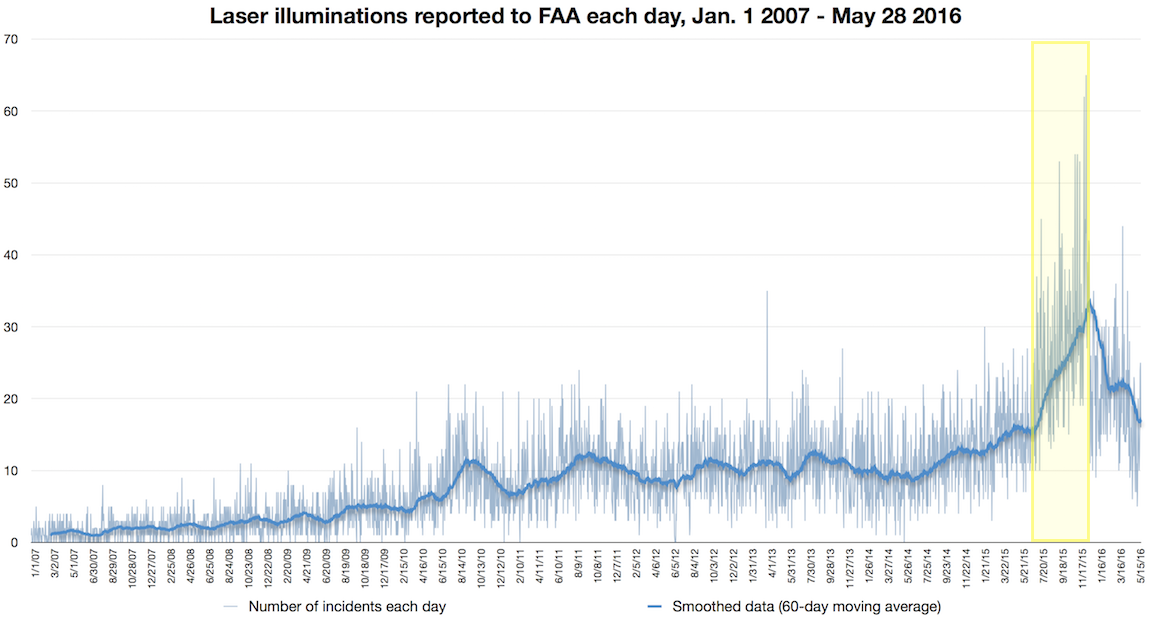
Click for larger image
A closer look at the past two years shows this more clearly:
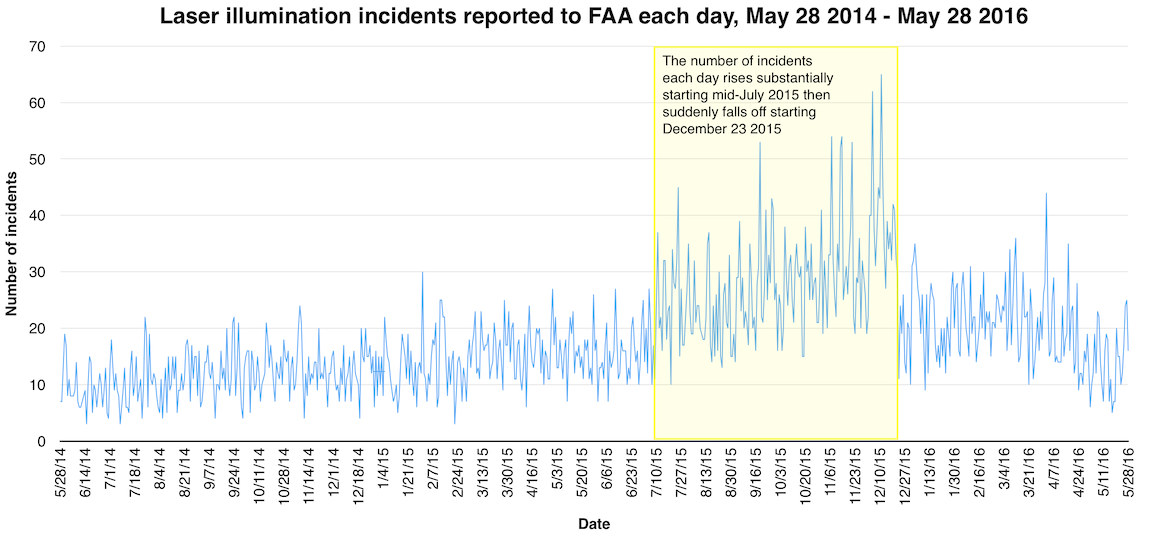
Click for larger image
A possible cause of the increase is that on July 16 there was widespread nationwide publicity about 11 flights that were illuminated on July 15 in and around New Jersey.
However, this event is not a full explanation. While the publicity may have triggered a “copycat” effect, incidents had been increasing at least two weeks prior to July 16.
LaserPointerSafety.com is not aware of any other external events such as new laser pointer products, changes in laws, etc. that could also account for this increase. And, we have no explanation for the dramatic fall-off starting December 23. We have reached out to FAA to find out if there were any changes in pilot reporting requirements or in data gathering procedures.
Knowing reasons for the increase — and especially for the sudden decrease — could provide clues in the effort to reduce laser pointer incidents in the U.S.
US: UPDATED - 2016 laser incidents up 33% over same period in 2015
From January 1 through May 28 2016, pilots filed 2,925 reports of laser illuminations with the U.S. Federal Aviation Administration. This is a 33% increase over the 2,194 reports filed during the same period in 2015.
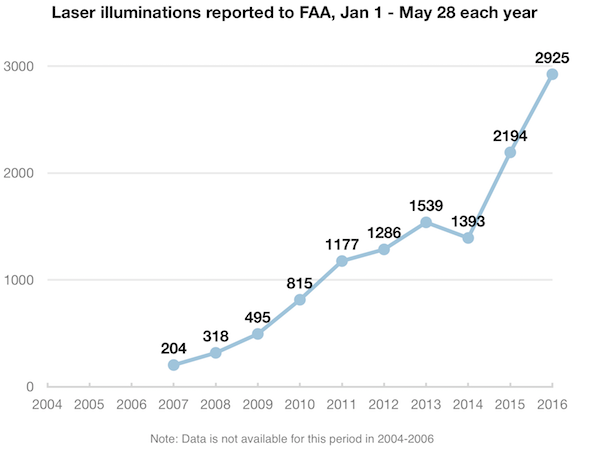
LaserPointerSafety.com estimates there will be over 8,500 laser incidents reported for 2016. This is based on comparing the number of illuminations Jan 1 - May 28 2016, with the average of the same period in the past four years.
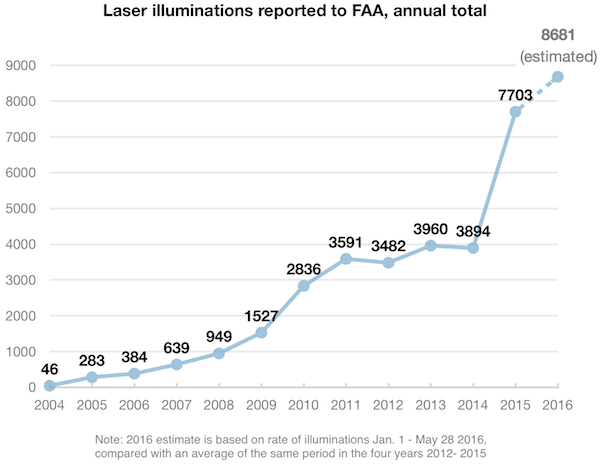
Australia: Study shows laser pointers are #2 cause of pilot incapacitation
There were 113 flight crew incapacitations in Australia during the study period — an average of about 23 per year. Of these, 15 (13.3%) of the reported incapacitations were due to laser strikes.
The study looked at “high-capacity” and “low-capacity” air transport, as well as general aviation.
During the study period there were 1,316 laser strikes reported to the ATSB in high-capacity operations. Of these, eleven (0.8%) of the laser strikes resulted in flight crew incapacitation.
A summary of the ATSB study is here. The full 30-page PDF document is available online from ATSB or from a local copy here at LaserPointerSafety.com.
Canada: Transport Canada warning of laser dangers via social media
The campaign began with a press conference where Marc Garneau, Minister of Transport and Tony Cusimano, Superintendent of York Regional Police spoke about the hazards.
Garneau said, "Pointing a laser at an aircraft is not only a reckless act that puts people at unnecessary risk, it’s simply not a bright idea. As Minister of Transport, I take this type of behaviour seriously because Canadians and their families deserve to feel safe while flying. We want people to know there are serious consequences, including $100,000 in fines and up to five years in prison. Transport Canada and law enforcement across the country are working together to ensure offenders face the fullest force of the law.”
Transport Canada has set up a website at www.tc.gc.ca/NotABrightIdea. It includes a catchy animated video, “Dumb Ways to Blind” aimed at millennials, plus three other more conventional videos on the topic.
According to the website, “[i]n 2015, there were almost 600 reported incidents.” This was an increase over the 502 incidents reported in 2014.
Transport Canada urges those interested to use the hashtag #NotABrightIdea. On Twitter, since January 1 2016 there have been about 40 posts with this hashtag; 33 of them about lasers and 7 about other topics that are “not a bright idea.”
From a news release issued by Transport Canada
Australia: Laser incidents rose 2007-2012; fell from 2013-2015
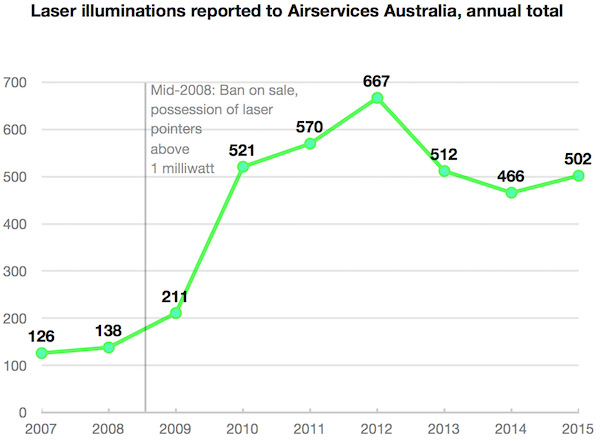
Compare this with the number of illuminations in the United States over the same period:
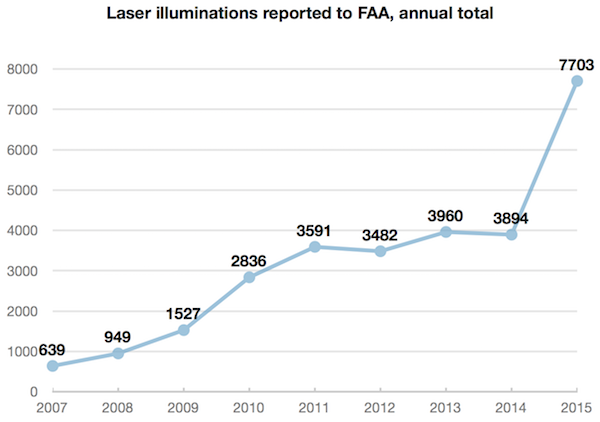
Australia’s data roughly tracks the U.S. data during the period 2007-2012. Here are the two charts above, superimposed, with the Australia numbers multiplied six times. The slope of the lines are similar for the first six years.
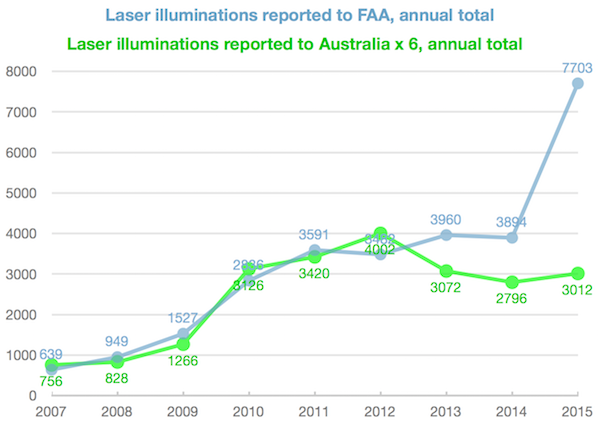
Data from Airservices Australia, a corporation owned by the Australian Government whose services include air traffic control and aeronautical data. The information was provided in response to a LaserPointerSafety.com media inquiry. Thanks to Amanda Palmer for her assistance with the request.
Canada: 663 laser/aircraft incidents in 2015 based on newspaper analysis of CADORS data
Here is the CADORS data:
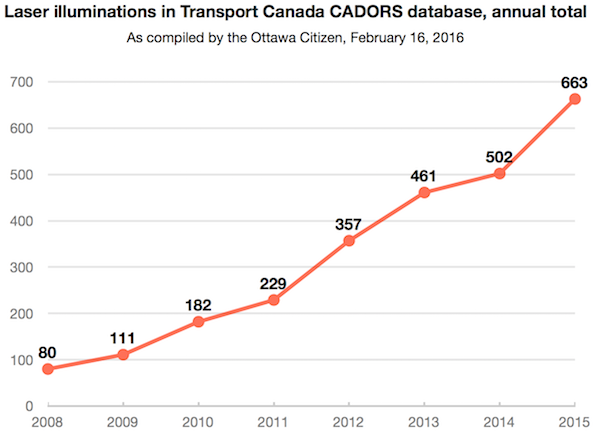
Compare this with the number of illuminations in the United States over the same period:
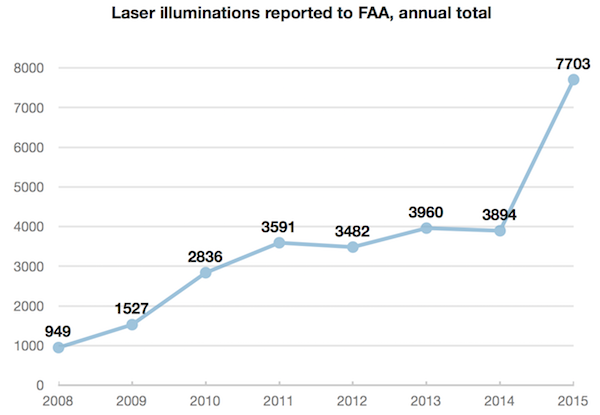
Canada’s data roughly tracks the U.S. data. Here are the two charts above, superimposed, with the CADORS numbers multiplied 11.7 times. The slope of the lines are similar for all but 2013/2014, and the endpoints are remarkably close.
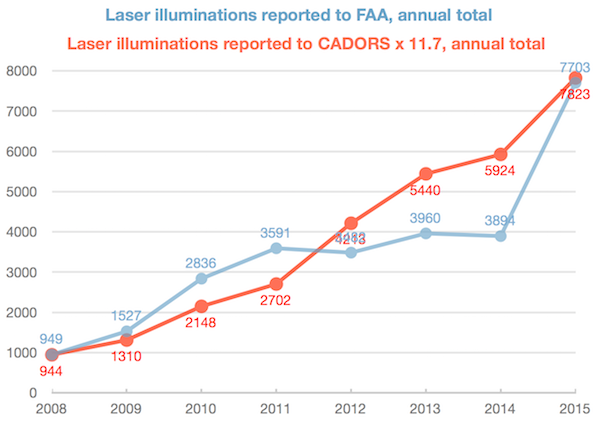
From an analysis by Andrew Duffy in the Ottawa Citizen. Note that a few days earlier, CBC News stated that there were 590 laser/aircraft incidents in 2015. There is no indication as to reasons for the discrepancy.
South Africa: One incident roughly every two days in early 2016
From htxt.africa
Canada: 590 laser/aircraft incidents in 2015; pilot group wants handheld lasers classed as weapons
The head of the Air Canada Pilots Association said that the figures show that education is not working, and handheld lasers should be designated as prohibited weapons.
From CBC News. Note that a few days later, the Ottawa Citizen did an analysis of Transport Canada’s database which shows different figures: 663 laser incidents in 2015, which is up 32% from the 2014 total of 502.
UK: Around 9,000 laser incidents, Jan 2009 - June 2015, according to CAA
For comparison, in the United States from January 1 2009 through May 31 2015, there were 21,414 laser incidents reported to the Federal Aviation Administration. (An additional 457 incidents were reported during June 2015.) From January 1 2004 through December 31 2015 there were 29,097 laser incidents reported to FAA.
U.K. information from the Daily Mail. U.S. information from FAA data.
US: UPDATED - Laser incidents nearly double in 2015 to 7,703
he number of FAA-reported laser incidents nearly doubled in 2015, to 7,703. This is a significant increase over the 2010-2014 period, which had hovered around 3,500-4,000 incidents per year.
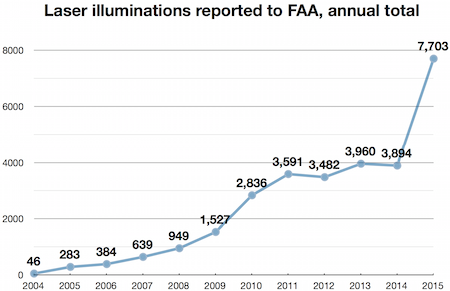
Here is the same data, presented to show the number of incidents per day:
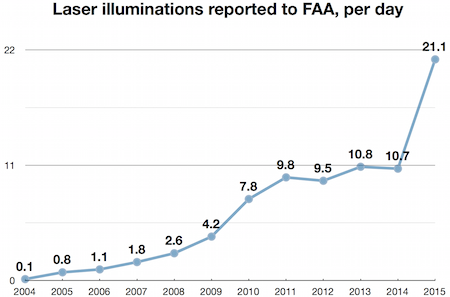
Below is a closeup of the 2014-2015 data. The thin light blue line represents the number of incidents on each day. Note the wide variability, from as few as no reports in a day (May 27 2014) to as many as 65 on December 11 2015.The thick blue line is a 30-day moving average, to smooth out the data.
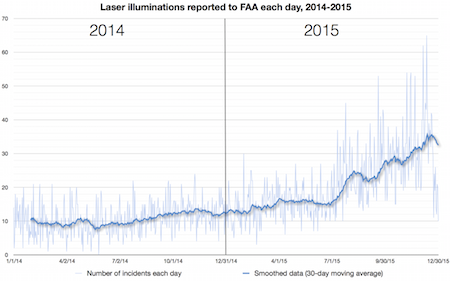
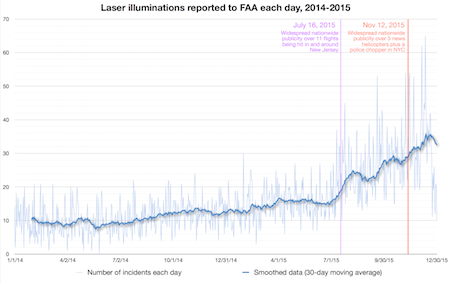
Both charts show identical data. On the second chart, two dates have been highlighted. Around July 1 2015, the number of incidents per day (light blue line) starts to increase. The only significant change that LaserPointerSafety.com can find around that time, is that on July 16 (purple line) there was widespread nationwide publicity about 11 flights that were illuminated on July 15 in and around New Jersey.
However, this event is not a full explanation. While the publicity may have triggered a “copycat” effect, it is apparent from both the thin and thick lines that incidents had been increasing at least two weeks prior to July 16.
Another date with widespread nationwide publicity is marked, November 12 2015 (red line). Three news helicopters and a police helicopter were illuminated in New York City the night before. Again, while there is some increase in incidents after that date, there also was a consistent increase from July through November.
Based on this analysis, “Copycat” laser use does not seem to be a significant factor in the near-doubling of 2015 laser incidents.
Sweden: Study of 47 laser eye injury cases from 2013 to 2015
The main body of the 2015 study includes an analysis of the laser power versus the observed injuries.
The authors note “If the availability of the handheld lasers continues to increase, along with higher optical power and lower cost, we expect that the number of severe eye injuries will continue to grow. Also, the distance from which the lasers can be used to disrupt various societal functions, such as air traffic (pilots) and policing will also increase. Almost all the reported cases involve young children and teenagers. There is also a huge overrepresentation by males. Often the lasers are sold as toys and purchased by a relative as a gift to a child. Earlier reports originated almost exclusively from developed countries. This situation has now changed and more and more reports originate from developing countries. The problem is worldwide and hence there is a need to educate and inform the societies of this danger.”
The 47 new cases are listed in an appendix. Here is a random sample listing two of the cases:
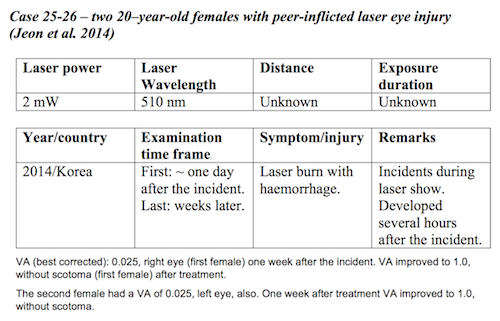
Author: Jörgen Thaung, Cesar Lopes and Stefan Löfgren
Publisher: Strål Säkerhets Myndigheten (SSM - Swedish Radiation Safety Authority)
Language: English
Publication date: December 2015
No of pages: 45
Price per publication: 100 SEK (incl. VAT)
Download: 2015:54 Retinal injuries from handheld lasers: An updated report [2200 kb]
A summary by LaserPointerSafety.com of the study’s objectives, major findings, and conclusion is here. The earlier 2013 study is summarized here and the full SSM document is available here.
US: Study of U.S. incidents, 2010-2014 gives insights into laser-aircraft safety
An AirSafe summary noted that from 2010 through 2014, there were only eight days with no laser encounters reported in the U.S. The graph below shows the distribution of incidents, with most days having between 7-12 laser strikes:
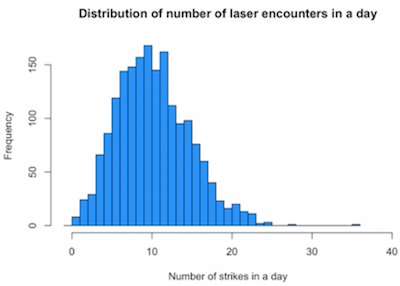
Analysis by day of the week, and by month of the year, showed Friday and Saturday evenings as having a greater likelihood of illuminations. July through November saw higher-than-normal numbers of incidents.
The AirSafe study also looked at six selected metropolitan areas. It compared the number of flights to the number of incidents. Phoenix, Los Angeles and San Francisco had higher-than-normal numbers of incidents; Chicago and New York were about average, and Atlanta was below average.
From AirSafe.com: summary page, and detailed analysis as a webpage, PDF and RPubs versions. Links are given to the raw FAA data, the processed version used by AirSafe, and statistical R code. Thanks to Dr. Todd Curtis who did the study and brought this to our attention.
UK: 400+ laser incidents in the first half of 2015
From January 1 to June 30 2015, there were more than 400 laser incidents reported to CAA. Heathrow had the most incidents by count, with 48 in the first half of the year. (This is actually fewer incidents per month than last year, when there were 168 total Heathrow laser reports for all of 2014.)
By proportion of laser incidents to air traffic volume, there was a higher frequency of attacks at regional airports such as Birmingham, East Midlands, Leeds Bradford and Newcastle.
The British Airline Pilots’ Association (BALPA) on November 2015 released the results of a survey of its pilot members, showing that 50% had reported a laser/aircraft incident during the period from November 2014 to November 2015.
From the Guardian and the Express. The CAA and BALPA statistics were released along with news of a British Airways pilot who reportedly suffered severe retinal injury from a spring 2015 exposure to a “military-strength” laser.
US: Slightly more than average number of laser incidents grabs media attention
Except for the involvement of multiple helicopters in New York City, the twenty November 11 overnight events were actually close to the current 2015 average of the 18.3 reported incidents per night.
It is normal for day-to-day incident numbers to fluctuate. For example, a day later on November 12, there were six incidents according to Slate.
Another example of the variability of daily incidents is shown by the day-to-day numbers for 2014. During the year there was an overall average of 10.7 incidents per day. The graph shows that daily numbers (light line) varied from 0 reported laser incidents to 24. (The dark line shows a 30-day moving average, to help smooth out the data. Day-to-day figures for 2015 are not yet available.)
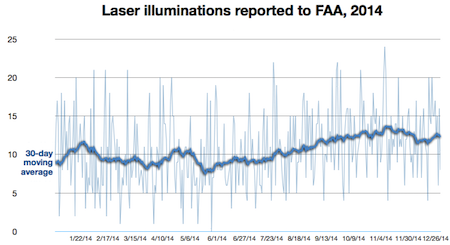
The U.S. Federal Aviation Administration made a Facebook post describing the November 11 incidents:
More than 20 aircraft were struck by lasers from the ground last night while flying over cities across the United States. Three laser strikes were reported in the New York City/Newark, N.J early in the evening, followed by three incidents in Texas, where jets were struck while preparing to land at Dallas Love Field. By late evening, pilots reported laser incidents in:
New York/Newark; Dallas; Jamestown, NY; Oakland, CA; Covington, KY; Danville, KY; Palm Springs, CA; Salt Lake City; Los Angeles; Albuquerque; Detroit; Ontario, CA; St. Petersburg, FL; Springfield, IL; San Juan, PR; Sacramento
None of the pilots reported injuries. Nevertheless, shining a laser at an aircraft is a federal crime that the U.S. vigorously pursues. Lasers distract pilots from their safety duties and can lead to temporary blindness during critical phases of flight, such as takeoff and landing. In some cases in the past, pilots have reported eye injuries that required medical treatment.
As of Oct. 16, the total number of laser strikes around the U.S. this year was 5,352.
Media stories that referenced the incidents included the following headlines and leads:
With new flurry overnight, laser strikes on aircraft hit record pace, USA Today
“Laser strikes on planes are growing even as the federal government enacts tougher penalties for people caught shining the devices. Overnight Thursday federal authorities fielded reports of more than 20 laser strikes on aircraft, adding to an already record-breaking number of strikes this year.”
Overnight outbreak of lasers pointed at aircraft, CBS Evening News
“The FAA says 20 aircraft were targeted by people with bright laser pointers Wednesday night in cities across the nation. Kris Van Cleave reports on the surge in these types of incidents.”
FAA: Lasers beams hit more than 20 aircraft overnight, Washington Post
“Federal authorities have launched an investigation after numerous aircraft were hit by laser beams Wednesday night. More than 20 aircraft were struck while in flight over at least 16 U.S. cities, according to a statement from the Federal Aviation Administration. Authorities said three strikes were reported to the FAA in the New York City area, followed by three in Texas that hit jets that were preparing to land.”
Lasers hit 20 aircraft flying in U.S. overnight - FAA, Reuters
“Dangerous beams from handheld lasers struck 20 aircraft flying over the United States and its territories overnight, among the nearly 5,400 laser hits in the nation so far this year, the Federal Aviation Administration said on Thursday. No injuries were reported in the incidents, which took place from New York City to Sacramento, and resulted in at least one arrest. Authorities said the incidents did not appear to be linked to each other.”
6 aircraft hit by lasers in New York, Dallas on Wednesday, Fox News
“Three news helicopters in New York and three planes near Dallas were hit by laser beams on Wednesday, according to the Federal Aviation Administration. Pilots for choppers flying for CBS New York, WNBC and WABC each described seeing a laser in their cockpit while flying over a scene in Park Slope, Brooklyn, CBS reported.”
High Number Of Laser Strikes In One Night Has Pilots Uneasy, CBS Sacramento
“The Federal Aviation Administration is looking into a series of laser strikes on aircraft across the country, including a possible strike at Sacramento International Airport. The exact details of that reported laser strike have not been made available yet, but for pilots these little beams of light are a huge concern. It was a busy night for law enforcement and air traffic control across the nation, with more than 20 pilots reporting laser pointers aimed at their cockpits.”
US: From 6,500 to 7,100 laser incidents estimated for 2015
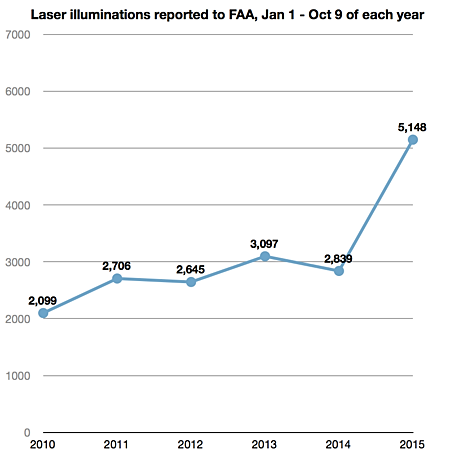
Based on trends in the years 2010 through 2014, this means that at the end of 2015 there could be between roughly 6,500 and 7,100 reported incidents. (The range is because in some years, the yearly total was between 1.28 and 1.37 times the Jan. 1 - Oct. 9 total.) We estimate that 2015 is likely to have roughly 6,850 incidents. This would be 176% of the 2014 total of 3,894 incidents.
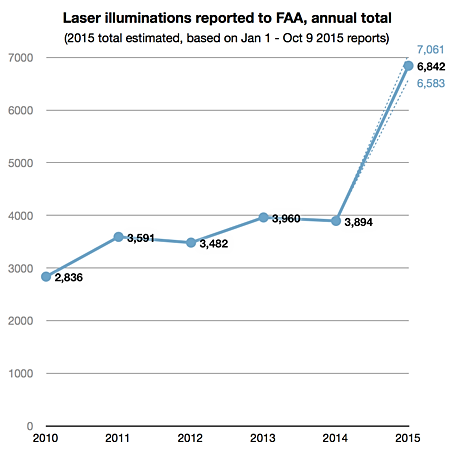
Stated on a daily basis, the number of reported incidents is expected to rise from 10.7 per day in 2014 to between 18.0 and 19.3 per day in 2015.
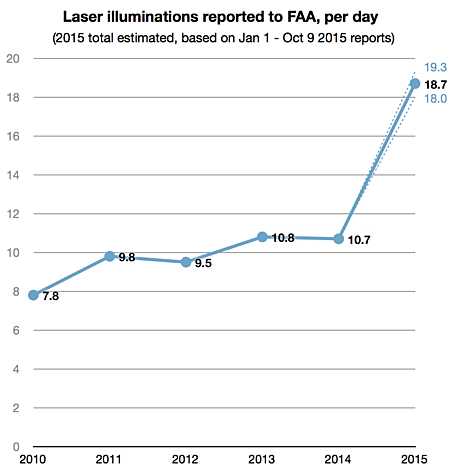
2015 information provided by FAA on November 5 2015. Statistical analysis done by LaserPointerSafety.com based on prior year FAA records.
Canada: Saskatoon officials warn about laser pointer hazards
One pilot said that lasers have been pointed at him “at least 10 times in the past 3 years.”
A CJME news story notes that “pointing a laser at planes could land those responsible in hot water under the Canadian Aviation Regulation Act. Potential penalties range from fines of $3,000 to multi-year probation sentences and incarceration. Charges could also include mischief, assault with a weapon and assault of a police officer.”
From CJME.com and 620CKRM.com
Saudi Arabia: Handheld blue-light lasers can cause macular hole in retina
The study, reported in the July 2015 American Journal of Ophthalmology, looked at 17 eyes of 17 patients at two institutions, between January 2012 and May 2014. Most were youths (mean patient age 18 years; range: 11 to 30 years old). The eyes were exposed to blue laser light for less than one second, at a mean distance estimated to be about 1 meter from the laser. The time from exposure to the patient visiting the hospital for treatment ranged from two days, to almost 500 days.
Patients were given a full ophthalmic examination, including fundus photography, macular spectral-domain optical coherence tomography, and fundus fluorescein angiography.
The macular holes ranged from 0.17 millimeters to 0.62 mm, with a mean diameter of 0.35 mm.
In 14 of the eyes, surgeons went deep into the eye and removed vitreous gel (a pars plana vitrectomy); this removes clouded gel that may contain blood from the injury. At the same time surgeons also did a procedure called “internal limiting membrane peeling,” which uses an instrument to make a break in the membrane which is then peeled away with forceps.
In 11 of the 14 eyes, the operation completely closed the macular hole. Of the other three unoperated eyes, the eye with the smallest macular hole spontaneously closed.
Before the operation, the mean Snellen best corrected visual acuity (BCVA) was 20/210, or about 1/10th the normal visual acuity; the range was from 20/30 to 2/200. After the operations, the mean BCVA was 20/62 (range: 20/20 to 4/200). These statistics included all eyes (the 14 operated eyes and the three unoperated ones).
The authors concluded “Full-thickness MH can result from momentary exposure to high-power handheld laser devices. While spontaneous closure may occur in rare cases, most cases require early surgical intervention. Vitrectomy may be successful in closing the macular hole with visual acuity improvement in most of the cases.”
From the abstract of the study by Alsulaiman SM, et al., “Full-Thickness Macular Hole Secondary to High-Power Handheld Blue Laser: Natural History and Management Outcomes” in the American Journal of Ophthalmology, July 2015 Vol. 160, Issue 1, Pages 107-113.e1.
Note: Other studies have been published based on this data, an August 2013 LaserPointerSafety.com story about the first study is here.
US: FAA-reported laser incidents up significantly in 1st half of 2015
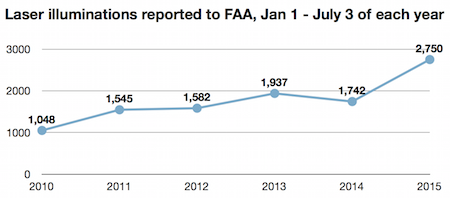
Based on past years’ trends, this means that at the end of 2015, there could be between about 5,600 and 7,400 incidents. (The range is because in some years, the second half of the year had 2.04 to 2.71 times the number of incidents in the first half.) We estimate 2015 is most likely to have about 6,300 incidents. This would be a 62% increase over the 2014 total of 3,894 incidents. 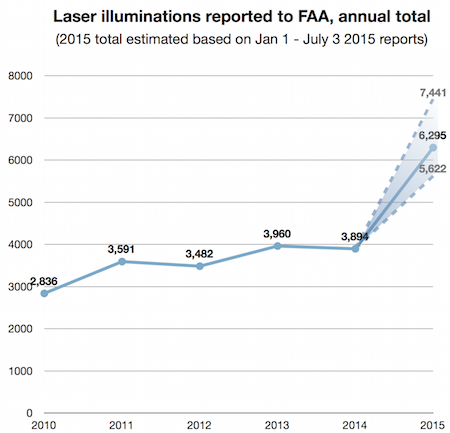
Stated on a daily basis, the number of incidents is expected to rise from 10.7 per day in 2014 to somewhere between about 15 and 20 incidents per day in 2015: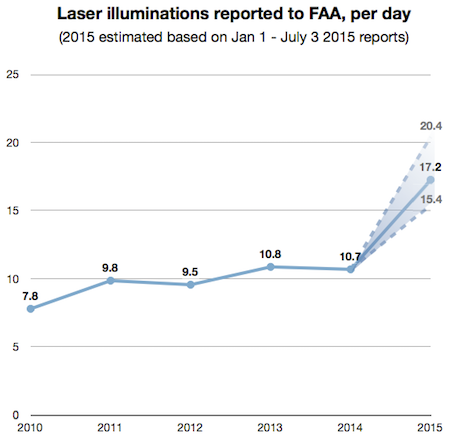
2015 information provided by FAA on July 10 2015. Statistical analysis done by LaserPointerSafety.com based on prior year FAA records.
Canada: Government launches safety campaign to warn against pointing lasers at aircraft
Helping Canadians better understand the dangers lasers pose to aircraft
The Honourable Alice Wong, Minister of State (Seniors), on behalf of the Honourable Lisa Raitt, Minister of Transport, today launched the Government of Canada’s safety awareness campaign for lasers. The national campaign will help Canadians better understand why pointing a laser at aircraft is not a bright idea.
The first phase of the campaign, unveiled today in collaboration with the Vancouver International Airport, the RCMP, and NAV CANADA, provides the public with an easy to follow infographic, which clarifies the dangers and consequences of pointing lasers into airspace and how incidents can be reported. This summer, the second phase of the campaign will include digital advertising, awareness videos and a direct mail campaign near three major airports.
Transport Canada has also launched tc.gc.ca/NotABrightIdea, which provides Canadians with the information they need to better understand the dangers of pointing a laser at an aircraft.
Transport Canada is working closely with police, other government departments, and the aviation industry to protect pilots, passengers, and people on the ground. If you see a laser pointed at an aircraft, report it to your local police.
Quick Facts
- The number of lasers pointed at aircraft is rising in Canada. In 2014, there were 502 reported incidents – a 43% increase since 2012.
- Aiming a laser at an aircraft is a federal offence. If convicted under the Aeronautics Act, an offender could face up to $100,000 in fines, 5 years in prison, or both.
- Canadians can join the conversation and learn more by using the #NotABrightIdea hashtag on Twitter.
Italy: Sharp rise in laser incidents to 1,189 in 2014
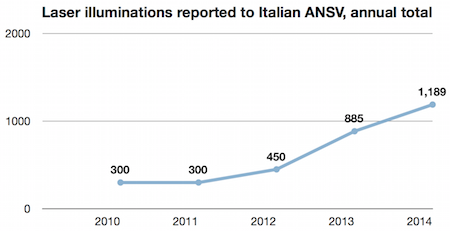
80% of the cases involved aircraft on approach, 15% involved aircraft taking off, and 5% happened during cruise.
The commander of the border police said he has never been able to identify the laser perpetrators. The fact that incidents occur in the dark, “coupled with the fact that a laser pointer can be easily hidden, makes it impossible to identify those responsible, unlike those who throw stones from the flyover. We think they are guys who do not realize the severity of what they do."
From Corriere Della Sera. Thanks to Alberto Kellner Ongaro for bringing this to our attention.
US: Survey paper says "Injury from laser pointer trauma is a public health problem on the rise"
It begins by summarizing misuse in sports, and in the thousands of incidents per year in the U.S. where lasers are aimed at aircraft.
The authors, Dr. Gregory D. Lee and Dr. David R. Lally, then write “Perhaps the greatest concerns are raised by reports of unsupervised children who have received these lasers as toys or gifts and expose themselves to the laser beams, causing permanent retinal injury with reduced central vision. From 2000 to 2009, there were five reports of 18 patients with injuries due to laser pointer exposure.”
They discuss the types of injuries (thermal, photochemical and mechanical) and locations of retinal injuries. There is a listing of laser classes, with “pointers” — Class 1, 2 or 3R (IIIa) — being distinguished from similar-looking but more powerful Class 3B and 4 “handheld” lasers.
The authors conclude as follows:
“Inappropriately used class 3B or 4 lasers should be considered weapons that can cause serious, permanent bodily injury. Even brief exposures to diffused rays of laser beams can cause temporary flash blindness that may last for hours in airline pilots, endangering the lives of passengers, particularly during takeoff and landing sequences. Cases of short-range laser exposure are becoming more common, often involving children who are inappropriately given these devices as toys, and these patients are referred to retina specialists after the damage has already occurred.
“No definitive experimental study, case report, or animal model has shown improvement in these injuries with any type of treatment, but typically these patients are treated with a short course of corticosteroids or nonsteroidal antiinflammatory drugs. Secondary choroidal neovascularization has been treated successfully with intravitreal anti-VEGF agents.13,14
“Clinicians, particularly retina specialists, can raise awareness of this rising public health issue by educating patients and parents about the hazards of laser pointers. Legislation is currently being written to impose stronger regulations on the distribution and sale of these devices. If a patient presents with findings of a laser-related retinal injury, clinicians should report the incident to the FDA so that investigations can be performed into the manufacturers of these devices. Reports can be made at www.fda.gov/downloads/AboutFDA/ReportsManualsForms/Forms/UCM236066.pdf.”
From Retina Today
US: Wall Street Journal examines link between males, laser offenders
It began by noting that in 89 of the 93 reported arrests last year for laser strikes against aircraft, the offender was male. The article quoted a New York laser safety officer, John Zelenka, as saying he has never seen a female playing with lasers.
A developmental psychologist was quoted as saying that lasers appeal to a masculine perspective. Patrick Murphy (editor of LaserPointerSafety.com) told the Journal “For a lot of guys it’s like, ‘The bigger the laser, the more visible, the more of a man I am.’”
Author Sophia Hollander then noted that the prices of a 20 mW laser dropped from $239 in 2004 to $8 in 2015.
She examined the similarity of “Star Wars” lightsabers and lasers, quoting experts on the appeal to males of a weapon that can “throw your influence.”
The online article was illustrated with photos from a lightsaber combat class held by the group New York Jedi. Actual lasers were not used in the class due to the potential hazards.
From the Wall Street Journal (article is behind a paywall)
UK: 1,442 laser incidents in 2014; up 3.4% over 2013
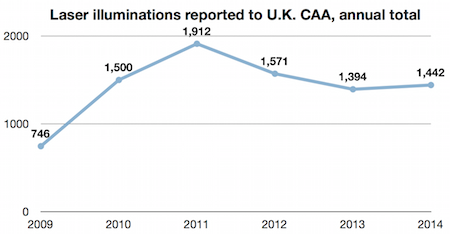
Additionally, there were 312 laser incidents that occurred outside the U.K. to U.K. operators.
In 2014, the top four most frequent incident locations were London/Heathrow (168), Manchester International (107), Birmingham (92), and Leeds Bradford (81). London/Gatwick and Glasgow were tied for fifth place, each with 64 reported incidents.
CAA published a PDF report with more detailed figures, including a monthly breakdown of the most frequent laser incident locations in 2014, and monthly & yearly totals for 2009 through 2014, and overseas (non-U.K.) incidents occurring to U.K. operators.
From the CAA PDF report dated February 2 2015. Note: There is a discrepancy where one table lists a total of 1,440 incidents in 2014 while another lists a total of 1,442. We have used the larger figure in this story.
Additional charts are on the page listing 2014 incident statistics, and the page with 2004-2014 historical data.
Canada: 502 laser/aircraft incidents in 2014
From the Transport Canada webpage Aiming a laser at an aircraft? Not a Bright Idea.
US: FAA releases spreadsheet with details of laser incidents, 2010-2014
This information was previously restricted and hard-to-obtain by the general public. The 3.6 MB Excel-format spreadsheet lists the date, time, aircraft ID, aircraft type, altitude, nearest major city, beam color, and whether an injury was reported.
The image below shows four days worth of data, January 1 through 4, 2014. Each row is one laser/aircraft incident.
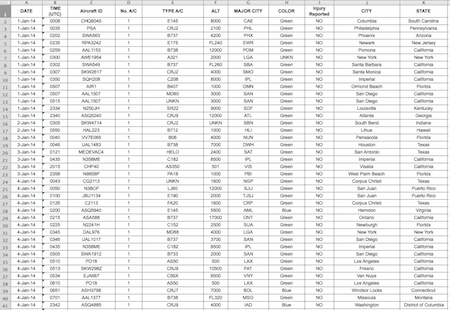
The spreadsheet, “Reported Laser Incidents for 2010-2014”, can be downloaded from FAA’s webpage Laser News, Laws, & Civil Penalties.
US: 3,894 FAA-reported laser illuminations in 2014; only 2.4% decline from 2013
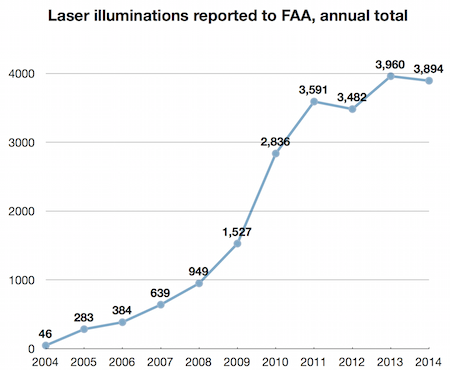
The chart below shows the number of incidents each day (light blue line) and a 30-day moving average (dark blue) to smooth out the data. In the first half of the year (Jan 1 - Jun 30) there were 9.4 incidents per day, but these rose in the second half to 11.9 incidents per day, making the 2014 final average of 10.7 incidents per day.
It is unclear why 2014 saw roughly level incident rates up to about June but then a steady increase over the next 5 months. One significant 2014 event was the February push by the FBI to publicize and prosecute laser pointer incidents, including offering a $10,000 reward. This was followed by another FBI push in June — after which rates started to rise.
The chart below shows 2014 in context with the past seven years. While the incident rates have leveled off to about 10-11 per day since 2011, all the publicity and prosecutions over the past few years have not brought the rate downward.
Finally, this chart superimposes each year’s laser illumination incidents, from 2009 through 2014. This gives an idea of the “shape” of each year. The heavy black line is 2014 data.
From public FAA Excel spreadsheet “Reported Laser Incidents for 2010-2014” at this page. For 2013 and previous years’ data, see the page FAA laser/aircraft incidents: 2004-2013 historical data.
Finland: 60+ laser-aviation incidents in 2014; safety campaign launched
The three groups are launching a campaign to inform the public of the dangers of aiming lasers at aircraft. A Trafi spokesperson says one person was caught misusing a laser against an aircraft, but was not convicted since the court could not establish intent.
From Yle
Arizona: Pilots will seek to upgrade laser pointing penalty to felony
The first draft of the April 2014 law called for a Class Five felony to “knowingly or intentionally” aim a laser towards an aircraft. But there was concern among legislators that juveniles could end up with a felony record. The bill passed once the penalty was reduced to a Class One misdemeanor.
In a September 22 2014 story, reporter Emilie Eaton recounted Arizona’s experience. FAA-reported incidents in the state rose from 138 in 2010, to 202 in 2013. One police pilot interviewed said that he had been hit by lasers over 100 times, during a 22 year career. The pilot, Chris Potter, said he had permanent damage from a laser strike: “It literally felt like I got punched in my eye and there was a piece of debris, like a piece of glass in my eye.”
Another pilot quoted, Pima County Sheriff’s Department deputy Chris Janes, said he has has between 12 and 24 laser strikes from 2007 to 2014: “I have not received any eye damage. But I’ve had headaches afterward. I’ve had eye discomfort for several days afterward.”
From Cronkite News, via the Tucson Sentinel
UK: 1300+ laser incidents in 2013
The newspaper also reported that in the 12 months between October 2012 and September 2013, there were 31 reports of aircraft being illuminated as they approached Gatwick Airport, 30 miles south of London.
Laser strikes have also increased on rescue helicopters flying out of Redhill Aerodrome, Surrey, a few miles north of Gatwick. A tactical flight officer was quoted as saying “I've had to break away from a task because of being lasered and it's not because we're trying to catch a bad guy, it's because we're trying to find people potentially in danger.... There are certain elements of society that might be trying to harm us or put us off being in a certain location.”
Police inspector Mark Callaghan told the Mirror that there have been a number of jail terms for perpetrators, but that "Hand-held lasers are easily obtained over the internet or from market stalls and street vendors abroad. The warning labels on these are misleading and they are more powerful than advertised."
From the Surrey Mirror
US: FAA-reported laser incidents decline 12.8% compared to 2013
During the 219 days from January 1 to August 7, 2014, there were 2,085 laser incidents reported to the Federal Aviation Administration, according to the FBI data. This is a 12.8% reduction compared with 2,390 incidents during the same 219-day period in 2013, and is an 8% increase compared with 1,925 incidents Jan. 1- Aug. 7, 2012.
One reason for the decline may be the FBI’s campaign to prosecute offenders, and to inform the public via press releases and public service announcements that it is illegal to aim a laser at aircraft.
Based on the Jan-Aug 2014 data, the number of illuminations in 2014 is expected to fall below 3,500.
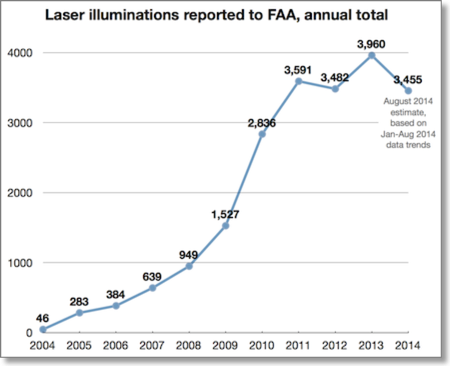
From information provided to LaserPointerSafety.com, and analysis of FAA data for previous years. For 2013 and past years’ data, see the page FAA laser/aircraft incidents: 2004-2013 historical data
Norway: 100 aircraft incidents one reason for proposal to limit pointers to 1 mW
The ministry received 18 official comments by the August 8 submission deadline. According to Dagens Medisin, “none of the answers are critical [of] mitigation in the use of laser pointers.”
The ban was supported by the country’s Civil Aviation Authority (CAA), the Radiation Protection Authority (NRPA), the Police Directorate and the Customs and Excise department.
The CAA said that there were around 100 incidents each year where lasers were pointed at aircraft in Norway.
If the measure is enacted, it will take effect beginning in 2015.
From Dagens Medisin, in the original Norwegian and in English (Google machine translation). The proposal and links to comments, can be found here in Norwegian, and here in English.
Ireland: Aiming at aircraft to be illegal, after 158 Irish incidents in 2013
The State Airports (Shannon Group) Bill includes the aiming prohibition; violation can lead to jail time or a fine of up to €50,000 (USD $66,800).
The action comes after 158 laser illuminations of aircraft in 2013, according to the Irish Aviation Authority. Forty-nine of the 2013 incidents involved Air Corps aircraft. From January to mid-July 2014, there were 11 Air Corps-related incidents.
A Fianna Fáil transport spokesperson said the legislation was helpful, but more should be done. He advocated targeting the sale and supply of lasers.
From the Irish Times and RTÉ News
UK: Police get advice from U.S. FBI on stopping U.K. laser incidents
While both the U.S. and the U.K. have laws with penalties up to five years in jail, in the States jail sentences have been imposed while fines are the norm in Britain. The U.S. also has a centralized national reporting system, which the British officials seek to emulate.
Mark Callaghan, an NPT inspector for Sussex Police, told the Express about a case in April 2014 where a laser beam was aimed at an Airbus A319 from a Travelodge near Gatwick Airport. The pilots reported that “The green laser was extremely aggressive and we suffered three or four two-second attacks directly into the cockpit causing blotchy vision, squinting, broken concentration, sore eyes.” The perpetrators were not caught.
Callaghan noted “We can find out who was in the rooms but we have no power to conduct any searches and even if there were lasers there what evidence is there to say they did it? We would like some preventative legislation. The US have got it nailed on how they deal with this.”
From the Express
New Zealand: UPDATED - Laser strikes leveling off, 3 months after nationwide laser restrictions
Associate Health Minister Jo Goodhew said “Early data seems to show that the number of laser strikes on aircraft have plateaued at the same level as last year.” From Jan. 1 to mid-May 2014, there have been 37 laser incidents. This compares with 116 recorded incidents in all of 2013.
The legislation, which took effect March 1 2014, did not make possession of lasers over 1 milliwatt illegal, but it did restrict importation and sales.
Goodhew said over 80 retailers had been visited to remove any over-powered lasers from shelves and to remind sellers of the new restrictions. Tests showed that of 22 lasers suspected of being over 1 milliwatt, 17 were in fact over the limit. Online auction sites have been monitored. Import officials seized 10 lasers as well.
Nine applications have been submitted seeking government approval to import, supply or acquire a laser pointer over 1 mW. Five have been approved and one is being considered. (Presumably the other three were rejected.)
From Voxy.co.nz. Other LaserPointerSafety.com coverage of New Zealand statistics and laws is here.
UPDATED June 26 2014: LaserPointerSafety has received some clarifications from Jo Goodhew’s office:
1) The 37 laser strikes were from January 1 2014 to mid-May 2014.
2) A March 5 2014 article in the New Zealand Herald, which stated there were 119 recorded incidents in all of 2013, is incorrect. The correct number is 116 as stated in the main article above.
3) The statistical analysis of the “plateauing” laser incidents in 2014 was done as follows: The 37 strikes from Jan to mid-May 2014 were extrapolated to give an estimated 104 strikes for 2014. This was then compared with the 116 incidents in 2013. Although this indicates that 2014 might be a decrease compared to 2013, “at this stage we are being cautious and describing it as a ‘plateauing’.” [Note: This statistical analysis would be correct if the rate of lasing is approximately equal throughout all months of the year. However, LaserPointerSafety.com has found that the rate varies with seasons; in the U.S. incidents tend to go up during the Northern Hemisphere summer. If New Zealand’s rate also varies significantly with seasons, then the statistical analysis is flawed. It would be better to compare Jan to mid-May 2013 directly with Jan to mid-May 2014.]
US: 134 laser arrests, 80 convictions, out of 17,725 incidents, 2005-2013
Farivar noted that there were 80 convictions among the 134 arrests. One reason for the conviction rate of 60%: some who were arrested were minors who were never formally charged.
The extensively researched 4,200-word article, dated May 21 2014, was based around the 14-year sentence handed down in March 2014 to Sergio Rodriguez, for his August 2012 aiming of a laser at two helicopters, one medical and one police. Farivar used the case to illustrate many laser/aviation issues, especially about how prosecution is being used to try to educate and deter future incidents.
Farivar interviewed Karen Escobar, who has brought more cases against laser perpetrators than any other federal prosecutor. Her territory includes Sacramento, Fresno, and Bakersfield.
In the article, Escobar was quoted as saying “At sentencing, [Rodriguez] did not accept responsibility for his actions; he blamed his 2- and 3- year-old children. I believe the evidence showed the laser was a dangerous weapon, and there was intention, supporting a guideline sentence of 168 months. I would not call it harsh. I would say it is a penalty that fits the crime, but I believe that it will have a deterrent effect, and I hope it will.”
Farivar noted that, “While 14 years might sound incredibly excessive for an incident that caused no serious or lasting physical injury, much less death, this is the emerging reality for attorneys prosecuting laser strikes. The Rodriguez sentence now serves as an example of what can happen to defendants who don't take plea deals. (The plea deals typically end up being around two years.)”
From Ars Technica
US: 129 laser/aircraft incidents in Florida thus far in 2014
The NBC Miami “Team 6 Investigators” did a report on laser incidents, how pilots are endangered, and the enforcement effort to find perpetrators. The report aired May 16 2014.
From NBCMiami.com
New Zealand: 119 laser/aircraft incidents in 2013 help lead to 2014 restrictions
On March 1 2014, new legislation took effect which severely restricts access to lasers over 1 milliwatts only to those with a legitimate use, such as astronomers.
A Jetstar spokesman said they regarded the pointing of lasers at aircraft as highly irresponsible and welcomed the new legislation.
Air New Zealand spokeswoman Brigitte Ransom said the new regulations were a positive step in mitigating the risks.
From the New Zealand Herald and the Manawatu Standard
Canada: After 461 lasings in 2013, pilots want stricter penalties plus government controls on lasers
In addition, Capt. Craig Blandford said “We’d (also) like to see a control put on them, some kinds of permits or access to these things that’s somehow controlled. I’m not sure to go so far as to say we want them on a prohibited weapons list, but that’s one of the things that we’re pursuing in order to get stricter on control.”
In 2013, there were 461 laser/aircraft incidents reported to Transport Canada, as compared with 357 in 2012. As of February 12, there have been 44 incidents in Canada during 2014.
From the Ottawa Citizen. The story includes additional details on Canada statistics and the pilots’ proposals.
US: 96 FAA enforcement actions in two years
During this timespan according to agency records, there were 7,149 reported incidents. This means that the FAA investigated 2.1% of the incidents, and took enforcement action in 1.3% of the incidents.
There were no specific details about how many enforcement actions resulted in a conviction and/or penalty such as a fine or jail time. The agency did say in general that “Federal, state and local prosecutors have sentenced laser violators to jail time, community service, probation and additional financial penalties for court costs and restitution.”
The press release distinguished between accidental and deliberate use of lasers: “The FAA’s guidance for agency investigators and attorneys stresses that laser violations should not be addressed through warning notices or counseling. The agency seeks moderately high civil penalties for inadvertent violations, but maximum penalties for deliberate violations.
From the FAA’s Fact Sheet - Laser Strikes
US: 3,960 laser incidents reported to FAA in 2013
Other news based on the statistics:
- In 2013, there were no incidents documented by FAA as causing eye injuries. Although there were incidents with eye effects such as temporary flashblindness, afterimage, blurry vision, eye irritation and/or headache, no incidents were serious enough to be tabulated as “eye injuries” by the agency. The FAA did say that in 2013, there were 35 incidents where pilots who were lased sought medical attention.
- The closer an aircraft is to the ground, the greater the likelihood of reporting a laser incident. There is a strong peak in the number of incidents at 1000-3000 feet above ground level.
- The color green was reportedly seen in the vast majority (92.8%) of incidents. Blue was a distant second with 2.4% of incidents.
- For states, California had the most incidents (734), followed by Texas (416) and Florida (326).
- For cities and regions, LaserPointerSafety has determined the Los Angeles area, including Van Nuys and Burbank, leads the nation with 147 incidents. Portland Oregon is second with 137 and Houston is third with 124. (Note that LaserPointerSafety.com tabulates regions slightly differently than the FAA or FBI, so these federal agencies may have slightly different numbers or rankings.)
- FAA tabulates each incident according to the closest airport. For 2013, Portland (Oregon) International led this category with 133 incidents. Phoenix Sky Harbor International was second with 111, and Marin International in San Juan, Puerto Rico was third with 107. This does not necessarily mean that incidents occurred at or near these airports -- just that these were the closest airports to the reported incident.
Full details are on the 2013 laser/aircraft incidents page.
New Zealand: NZ restricts handheld lasers over 1 milliwatt
The regulations were based in part on public submissions made in response to a November 2012 Ministry of Health proposal. Submissions were received from organisations including retailers, government agencies, non-government organisations, professional associations, importers, the aviation industry, members of the public and other organisations with an interest in high-power laser pointers. Their suggestions were compiled in a 20-page document which helped guide the new regulations.
"High-power laser pointers can cause eye injuries, even blindness, and skin burns. ACC accepts around 10 claims a year for these injuries," says Mrs Goodhew.
"They can also cause temporary flash blindness, which poses a serious risk if the person affected is a pilot or in charge of a vehicle or equipment. The Civil Aviation Authority reports around 100 laser strike incidents on planes each year.”
The new controls, under Health and Customs legislation, cover the import, supply and acquisition of high-power laser pointers. They do not currently restrict the possession of high-power laser pointers. A bill is before Parliament which, if passed, would make it illegal to be in a public place with a laser pointer without a reasonable excuse.”
"The new controls have been crafted to only target the high risk hand-held laser pointers with a power output of greater than 1 milliwatt,” Goodhew said. “The regulations are in line with Australia’s restrictions and recommendations by the World Health Organization.”
Click to read more...
Canada: Regina has 12 laser pointer incidents thus far in 2013
This compares with five laser incidents during 2012, and one during 2011.
The officials reminded the public that lasing an aircraft is illegal.
From CTV News and OHS Canada
Sweden: Detailed study released of worldwide laser pointer eye injuries
“The purpose of this study was to investigate what dose of laser radiation, in terms of intensity and exposure time, may be associated with eye damages. The study has been limited to unwanted exposures of laser radiation from commercially available laser pointers. Of particular interest has been to search for data that clarify the dose-response relationships for functional disabilities that persist more than 6 months.”
“The study shows that long-term vision loss can occur as a result of involuntary exposure from commercially available (strong) laser pointers at close range. The injury may occur before a normal person is able to respond by closing the eyelid, although there are only a few cases reported. A minor such damage is transient within a few days. It is also likely that such a visible injury to the retina becomes functional, i.e. prevents reading skills. What dosage is required for the disability to become permanent is not clear in the literature. Also, the dynamics of evolvement and repair of tissue damages and disabilities are hardly described at all.”
Author: Stefan Löfgren, Jörgen Thaung and Cesar Lopes
Publisher: Strål Säkerhets Myndigheten (SSM - Swedish Radiation Safety Authority)
Language: English
Publication date: 19 November 2013
No of pages: 50
Price per publication: 100 SEK (incl. VAT)
Download: 2013:30 Laser pointers and Eye injuries - An analysis of reported cases [1385 kb]
A summary by LaserPointerSafety.com of the study’s objectives, major findings, and conclusion is here.
UPDATED January 2016: The SSM released an update, with 47 additional cases worldwide of eye injuries from consumer lasers. A summary by LaserPointerSafety.com is here; the full SSM document is here.
US: Tucson police pilot says he has permanent retinal damage from laser exposure
The statement came as hundreds of Arizona law enforcement pilots attended a safety seminar in Tucson focusing on laser beam incidents. In 2012 in Tucson alone, the police department’s air unit had “close to 50 incidents”, according to Potter. As of November 2013, Phoenix was the top U.S. city for laser incidents.
From KVOA News
US: Latest FAA statistics show 3,188 incidents, Jan 1 to Oct 17 2013
The 2013 figure of 3,188 laser/aircraft incidents is 16.7% higher than the same period in 2012. If incidents continue at the same pace, there will be 4,063 incidents in calendar year 2013.
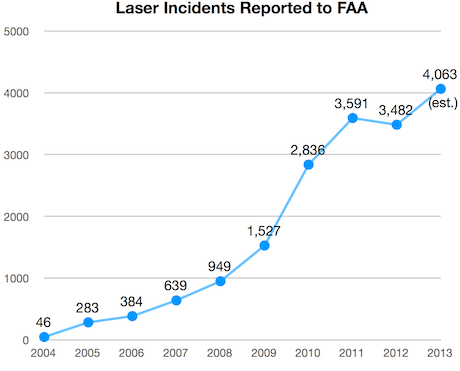
Total Incidents, 2004 to Date
There have been approximately 16,936 laser/aircraft incidents reported to FAA, from January 1 2004 through October 17 2013.For additional details on previous years, see the year-end statistics for 2012, 2011 and 2010.
Commentary from LaserPointerSafety.com
This 16.7% increase represents a setback from the 2012 totals, which were 3% lower than in 2011. Having a rise in 2013 incidents seems to indicate that the publicity and prosecutions which form the majority of current U.S. anti-laser efforts are not having the desired effect.
There has been some speculation that the 2013 figures differ from 2012 in part because FAA may have updated its incident reporting procedures. While FAA is working to include military and overseas incidents, this has not yet been done. In this respect the 2013 figures are directly comparable to earlier years.
Another possible explanation is that pilots have become more aware of the issue and are thus more likely to report a laser sighting. However, pilot information has been widely available since 2008 and has increased as this became of more concern. By now, most pilots should be alerted to the issue and FAA’s reporting requirements. There has not been a major push during 2013 in this area, so increased pilot reporting is probably not a major factor in causing 2013 reports to increase over 2012.
UK: Pilots want stronger laws, jail, for laser attacks
The Association says the lasers are too easily available, and that although it is illegal to aim a laser at an aircraft, the punishments have been too lenient: “Slaps on wrists and £150 fines are not enough.”
According to a September 29 2013 article in the Sunday Express, there were 1,570 laser incidents reported to the Civil Aviation Authority in 2012, and 1,911 in 2011. The most prominent airports cited were Birmingham, Manchester, Liverpool, the East Midlands, Bristol, Heathrow and Gatwick.
From the Sunday Express
New Zealand: Bill to make handheld laser possession in public illegal, passes first reading
The bill was originally introduced November 15 2012. The sponsor, National MP Dr Cam Calder, said the handheld laser pointers “have the potential to cause considerable harm, and put lives at risk when improperly used.” In addition to a penalty of up to three months in prison and up to a NZD $2000 fine (USD $1650), police also would be able to confiscate lasers.
Dr Calder told Parliament that the New Zealand Airline Pilots Association was “very much” in favor of the bill. In 2012, there were over 100 incidents where lasers were aimed at aircraft and moving vehicles.
According to NZ News, “Labor and the Greens supported the bill, although they had concerns the definitions in the bill might be too broad.” Below is the debate on the bill (after the “Read More…” link.) The bill was referred to the Transport and Industrial Relations Committee; their report is due on or before March 25 2014.
In addition, the Ministry of Health is developing regulations addressing the importation and sale of handheld lasers. They are expected to be announced by the end of 2013.
Click to read more...
US: FAA prosecutes 1.5% of all laser/aircraft incidents
This appears to describe civil cases brought by FAA based on violations of 14 CFR 91.11, which states “No person may assault, threaten, intimidate, or interfere with a crewmember in the performance of the crewmember's duties aboard an aircraft being operated.” The maximum penalty is an $11,000 fine. FAA announced on June 1 2011 its intent to charge laser perpetrators under this law, so the 129 cases referenced above would be since that time.
During the same time period, from June 2011 to September 2013, there were 8,507 reported laser/aircraft incidents in the U.S. This means that 1 out of every 70 reported incidents results in a civil prosecution. Stated another way, 1.5% of all laser/aircraft incidents result in a civil prosecution.
Click to read more...
Germany: 261 laser/aircraft incidents in 2012
This information was given by a spokesperson for Berlin Tegel airport, speaking after a September 8 2013 incident where a 14-year-old boy aimed a laser at three airplanes landing at the airport.
From BZ-Berlin (original German text and Google-translated English text)
Canada: Laser strikes up significantly in Edmonton
A police pilot spokesperson said laser users are not reading the packaging which clearly states not to aim at aircraft. After being caught, "There's been a lot of apologies, a lot of regret, some people not realizing the consequences of what they were doing, and then there's been the far opposite -- I can't believe this is happening, this is ludicrous, this isn't serious, it's just a laser pointer."
The pilot also said that a ban is not the answer: "If it's used properly, it's harmless. It's hard to ban something like that, the sale of it completely if 95% of the general public are using it properly."
He noted that not just police aircraft are being lased. Commercial and private aircraft also are at risk.
Edmonton police helicopter pilots are equipped with safety glasses for use during laser illuminations. They have two pair, one to attenuate red laser light and one to attenuate green laser light.
For details on the two most recent Edmonton incidents, on September 6 and 7 2012, see this LaserPointerSafety.com story.
From the Edmonton Journal and Edmonton Sun. Thanks to Keith Murland for bringing this to our attention.
UK: More than 220 laser attacks in two years in West Midlands, says CAA
This is roughly one-third of the 700 incidents over the same time frame that involved aircraft in or above the West Midlands. (The 480 non-laser incidents included bird strikes, emergency landings, a bomb threat, a dog on the runways and closure of an airfield because of a flying kite.)
On one occasion in July 2011, four different lasers were aimed at a police helicopter in a single incident.
The British Airline Pilots’ Association asked for prison sentences for persons caught aiming at aircraft, as well as regulations over the sale of high-powered lasers.”
According to West Midlands police, laser attacks on their helicopter have fallen in months prior to July 2013.
From the Birmingham Mail. See also a related LaserPointerSafety.com article on BALPA’s laser pointer suggestions.
New Zealand: Average of 8.9 laser injury claims per year, costing NZD $93.63 each
The laser injury claim rate has increased from about 5 per year to about 13 per year, over the 2000-to-2013 period. The increase works out to 0.73 additional claim per year. This increase is one reason that New Zealand is taking action in 2013 to restrict higher-power handheld lasers.
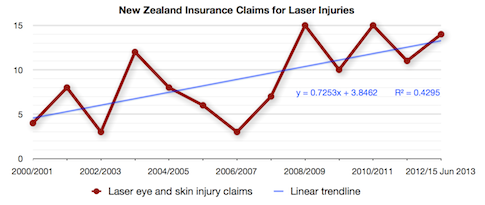
US: Laser/aircraft incidents have increased compared to 2012
In 2012 and previous years, FAA was able to release detailed weekly reports tracking the number, type, and other data about laser incidents. But due to budget considerations in 2013, FAA has not yet been able to disseminate any reports. Thus, there is some uncertainty in the 1,500 approximation.
Based on this uncertainty, LaserPointerSafety.com has calculated that there could be between 1% and 16% more laser incidents in 2013 than in 2012. If accurate, any increase would represent a setback from the 2012 totals, which were 3% lower than in 2011. Having a rise in incidents would indicate that the publicity and prosecutions which form the majority of current U.S. anti-laser efforts are not having the desired effect.
The 2013 estimate of 3,774 incidents is based on comparing FAA reports from Jan. 1 to June 12 2013 to the same time period in 2012, and then extrapolating the 8.4% increase over the entire year. However, FAA changed their reporting procedures in 2013 so it is unclear how much of the estimated increase, if any, is an actual increase and how much is due to the new reporting procedures.
For the last comprehensive FAA figures, see our page Latest 2012 laser/aircraft incident statistics.
UPDATE, August 16 2013: New information shows 2,200 incidents from January 1 through August 2 2013. This is an 18% increase over the same period in 2012. Also, it does appear that FAA’s 2013 incident reports are comparable to 2012’s -- they have not yet significantly changed their reporting procedures or criteria. More information is at this LaserPointerSafety.com story.
US: FAA study compares fixed-wing airplane laser incidents with helicopter incidents
The study found that helicopters were 3.4 times as likely to be illuminated at altitudes below 2,000 feet than fixed-wing aircraft. Helicopter aircrews were twice as likely to report adverse effects such as distraction, vision interference, operational problems, and pain.
The study also broke down adverse effects by the type of flight, such as commercial, law enforcement, medical and military.
One conclusion of the study is that the “results may also justify the expense of equipping rotary-wing aircraft (particularly law enforcement aircraft) with laser detection and tracking devices to improve the possibility of apprehending perpetrators of these offenses.”
A detailed summary is at LaserPointerSafety.com’s 2013 FAA helicopter study webpage. The full 6-page report is available online from the FAA.
US: North Wildwood NJ to ban laser pointer sales and possession
This was done after about 40 complaints to police in 2012, most of which "turned out to be kids playing with the laser pointers" according to the deputy police chief. The U.S. Federal Aviation Authority had also contacted the city regarding lasers pointed at aircraft. The ordinance language notes that "the illegal use of laser pointers creates risks and dangers for those targeted by the beam of the laser as well as for the residents of and visitors to the city of North Wildwood.”
Ordinance 1622 had its "first reading" on April 16, meaning it did not become law. The second reading, and possible adoption as a law, was set for the City Council meeting the evening of May 7 2013.
Click to read more...
Scotland: Pilots want stepped-up prosecution against laser attacks
An April 2013 investigation by the Scottish Express found 338 incidents in Scotland from January 1 2011 through February 13 2013. Only 12, or 3.5 percent, had been solved. The paper noted that the International Air Transport Authority (IATA) suggests there are 12 incidents involving lasers each day globally. [Note: The U.S. rate is approximately 9-10 per day, indicating the rest of the world’s rate is 2-3 per day which LaserPointerSafety.com believes to be higher.] An IATA spokesperson said the organization “support[s] strong penalties for anyone caught engaging in the act.”
The U.K.’s Civil Aviation Authority said there were 152 laser incidents at Heathrow Airport in 2012, compared with 136 incidents at Glascow Airport which has 1/10 the number of passengers.
The Scottish Express story contains additional statistics on Scotland airport lasing rates.
From the Scottish Express
World: Summary of papers presented at International Laser Safety Conference 2013
Laser pointer hazards for pilots
- A study of the actual output of 40 laser pointers, with powers up to 1.5 Watts, showed significant differences between measured and calculated hazard levels. In some cases, the actual hazard measured at some spots inside the beam was three times the estimated hazard. This is due to the laser output not being smooth in all cases, but instead the beams having “hot spots”. The study also showed that windscreens reduced the beam irradiance -- which is safer for pilots -- from 5% to 60%. (Note however that the McLin study described below showed that windscreens also spread the beam and thus increase glare.)
- A discussion of how being inside the Nominal Ocular Hazard Distance of a laser beam does NOT mean instant blindness for pilots and others.For example, consider a 1 Watt, 1 milliradian laser where the recommended safety distance (NOHD) is 733 feet. If possible, you should be at least 733 feet from the laser before exposing an eye to the direct beam. What is the actual hazard? At 232 feet from this laser, there is a 50/50 chance of the beam causing a barely observable retinal lesion under laboratory conditions where the laser and eye are fixed in place. Due to motion of the aircraft and hand-holding the laser, the chance of a retinal lesion is likely to be less. The distance from 232 feet (“ED50”) out to the NOHD at 733 feet is a known “safety factor” where the chance of retinal injury decreases even further. At the NOHD there is a “vanishingly small risk of hazardous exposure” (Sliney, 2013). Police and other first responder pilots can use this information to better weigh the risk of laser exposure to laser light vs. the benefits of completing a mission (rescuing a person, apprehending criminals, etc.). This presentation also discusses ways to make flight near lasers safer for pilots. A PDF file of all the slides presented is here.
For additional ILSC 2013 papers, click the “read more” link.
Click to read more...
US: 2012 laser/aircraft incident statistics
What is an FAA-reported “laser incident”?: This is defined as an aircraft pilot seeing one or more laser beams during flight. A mid-2011 study by Rockwell Laser Industries of 6,903 incidents reported to the U.S. Federal Aviation Administration found that in 27% of incidents, beams entered the cockpit (passed through the windscreen). For example, in 2011, there were 3,591 incidents of which approximately 970 (27%) involved beams in the cockpit.
Year-to-Date Comparison
The 3,482 reported U.S. laser/aircraft incidents in 2012 compare with 3,591 incidents during 2011, approximately 2,836 incidents during 2010, and approximately 1,527 incidents during 2009.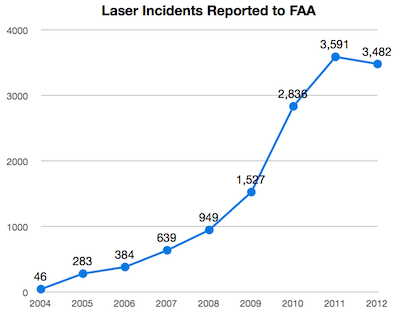
The number of U.S. laser incidents decreased slightly in 2012
Projected 2013 Estimate
If the number of laser/aircraft incidents in 2013 continues to decrease at the same rate as from 2011 to 2012 (-3.04%), then there would be 3,376 incidents in 2013.
Adverse Effects
In 36 (1.0%) of the 3,482 laser/aircraft incidents in 2012, a pilot or aircraft occupant reported a temporary adverse visual effect such as flashblindness, afterimage, blurry vision, eye irritation and/or headache. In four of the 36 eye incidents, the eye effect may have been more serious or long-lasting. In no incidents, either in 2012 or in previous years, was there any permanent eye damage.Total Incidents, 2004 to Date
There have been approximately 13,737 laser/aircraft incidents reported to FAA, from January 1 2004 through December 31 2012..
Click to read more...
UK: Leeds Bradford Airport has 3 laser incidents per week
From the Yorkshire Evening Post
South Africa: 170 laser incidents so far in 2012; up about 66%
The information came at an August 1 2012 press conference where representatives from SACAA, airline pilots, a laser expert, and others spoke about the potential hazards of lasers being aimed at aircraft. SACAA was planning a public information campaign to warn about laser-aircraft hazards.
Penalties include a fine or up to 10 years in prison. But only three people have been caught. One was a minor and charges were dropped. The other two cases had “dragged on in the courts and the SACAA had lost track of them.”
From The Citizen. Additional statistics and information are in a story from Defense Web.
Australia: 733 laser incidents in 2011; appears to be almost 3x the U.S. lasing rate
The story did not give additional details. It is assumed this data is for all of Australia, since DIT is a federal agency.
From The Age
Commentary from LaserPointerSafety.com: Australia’s laser/aircraft incident rate appears to be 2.8 times the U.S. rate, based on incidents per capita. This is despite the fact that Australia has nationwide import restrictions on laser pointers, and that many Australian states severely restrict or ban possession of laser pointers.
There may be other reasons for this discrepancy. Perhaps laser incidents are not counted the same way in these two countries. Perhaps population is not the best way to compare the two countries’ laser incident rates.
However, on first analysis it appears that Australia has a significant problem with lasers being aimed at aircraft even though widespread restrictions on availability and possession of laser pointers. This is a preliminary indication that bans and restrictions may not work as anticipated. They may need to be combined with other actions, or it may be that other actions have more of an effect to reduce the incident rate.
Calculation details: Australia’s population is estimated at 22,680,322 as of July 25 2012. Australia had 733 incidents in 2011 according to The Age story above. This is a rate of 1 incident for every 30,942 persons. The U.S. population is estimated at 313,979,000 as of the same date. The U.S. had 3,591 laser incidents in 2011. This is a rate of 1 incident for every 87,435 persons.
.
Italy: 10 incidents at Aviano NATO airbase in 18 months
From StrategyPage.com and Air Force Times
Canada: Laser statistics for 2010, 2011 and Q1 2012
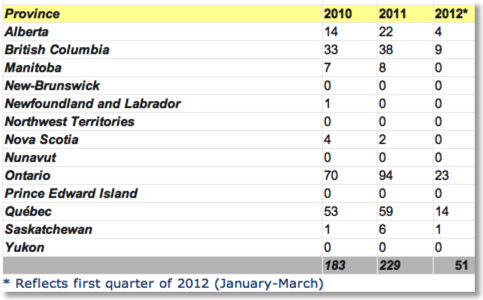
According to the Toronto Star, from January 1 to late May 2012 there have been 36 laser incidents at Pearson International and other Toronto-area airports, and 100 incidents nationwide. (This is probably based on their own analysis of the CADORS incident database since the Transport Canada chart above only went through the first quarter of 2012.)
WestJet has arranged for a Calgary-based ophthalmologist to examine pilots’ eyes after laser incidents. A spokesperson said “We want to have an individual identified in every major city so we can send that (pilot) right away to be tested.”
Canada lags other countries in aggressively prosecuting offenders, according to the chair of the flight safety division of the Air Canada Pilots Association: “The judicial system should apply the law to its maximum extent rather than soft-shoeing around the issue.” At the federal level, aiming a “directed bright light” at an aircraft is illegal under the Aeronautics Act. The maximum penalties are a prison term of five years and a fine of $100,000.
From the Toronto Star; chart courtesy Transport Canada
UPDATE, May 30 2012: At LaserPointerSafety.com’s request, Transport Canada analyzed first quarter incident statistics for the past three years. They found 29 incidents in Q1 2010, 27 incidents in Q1 2011, and 53 incidents in Q1 2012. (Note that they found two additional Q1 2012 incidents which were not included in the province-by-province breakdown above.) A Transport Canada spokesperson speculated that reasons for increased incidents in general may include increased awareness and reporting by pilots, and “copycat” actions by persons who would not think to aim a laser at aircraft until they hear news reports of incidents.
Scotland: 107 laser incidents in Glasgow in 2011
From the Scotsman
US: FAA to take harsher actions against persons aiming at aircraft
FAA has directed its staff not to seek warning notices or counseling, but to use “moderately high civil penalties” for inadvertent laser illuminations, and maximum penalties for deliberate violations.
In a video provided by FAA, LaHood said “I wonder how stupid people really can be” for not knowing that laser light could “cause great harm if the pilot is not able to continue to fly the plane safely…. people’s lives could be in jeopardy.” LaHood also said people should “understand that there are serious consequences to shining a laser at a pilot.”
The complete press release is below (click the “Read More...” link). This also has links to video and audio from LaHood and the acting FAA Administrator.
Click to read more...
UK: 15 laser incidents at East Midlands Airport in 10 months
Police warned of the hazards of endangering pilots and drivers, and noted that a violation could result in being sentenced to prison for life.
From This Is Derbyshire and the Loughborough Echo
UK: CAA issues Safety Notice to pilots, after 2,300 laser attacks in 2011
Below are highlights from the document, which gives some background information and statistics, and then describes how affected crew should prepare for and react to a laser attack. (Emphasis in bold added by LaserPointerSafety.com.)
Click to read more...
South Africa: 181 laser incidents in 2+ years
On March 25 2012, an ATNS statement noted that air traffic control towers have been illuminated by laser light, in addition to airplanes and helicopters. ATNS said there have been at least two arrests, but thus far, no prosecutions.
South African aviation groups are joining together to publicize the hazards and penalties of aiming lasers at aircraft. They are also considering strengthening laws. According to the statement, laser ownership requires a permit, but illegal sales are taking place via imports and black market stores.
From The Star via Independent Online, News 24, and the Daily News. Thanks to Dr. Ian Powell for bringing this to our attention. The ATNS press release is after the link (click “Read More…”).
Click to read more...
US & UK: UPDATED - Laser incident rate in U.K. more than twice the U.S. rate
- U.S. airports had 9,079,000 flights in 2011, with 3,591 laser incidents reported to the Federal Aviation Administration. This is a rate of one U.S. laser incident for every 2,528 flights. Said another way, this is 0.40 incidents per 1,000 flights.
- U.K. airports had 2,152,787 flights in 2011, with 1,909 laser incidents reported to the Civil Aviation Authority. This is a rate of one U.K. laser incident for every 1,128 flights. Said another way, this is 0.89 incidents per 1,000 flights.
The ratio of U.K. to U.S. rates is 2.24, meaning that the U.K. had more than twice the number of laser incidents than the U.S., when adjusted for the number of flights. (Important note: These figures do NOT mean that commercial aircraft are targeted at the rates indicated. Many laser incidents involve police helicopters. The analysis is simply meant to compare the two countries’ rates of laser misuse against aircraft of all types.)
It should also be noted that there could be many underlying factors affecting the precise numbers. For example, it is not known if the U.S. counts laser incidents in the same way as the U.K.
However, the figures do indicate that the U.K. rate of laser incidents appears to be significantly higher -- roughly twice the U.S. rate, based on the number of flights.
From an analysis by LaserPointerSafety.com, March 22 2012.
Updated May 27 2012 to correct a math error and make clear that it is the United Kingdom which has a higher rate of laser incidents (e.g., more incidents per 1000 flights). Our thanks to Brian Turner for pointing out this error.
Methodology: We define a “flight” as a takeoff plus a landing. US flight figures are from the Airline Activity “departures” statistic from the Department of Transportation’s Bureau of Transportation Statistics. It is assumed that each flight which departs also lands, so the data is accurate for “flights” as we have defined it. UK flight figures are from totaling column G, Total ATMs, from “Table 4, 1 Air Transport Movements 2011” found on the CAA UK Airport Statistics 2011 page. A UK “movement” is one takeoff plus one landing, so this is the same as our “flights” definition.
While the flight statistics compare only airline (US) and air transport (UK) flights, and do not include law enforcement flights, we believe this is a valid “apples to apples” comparison of how many more flights take place in the U.S. than in the U.K. A previous LaserPointerSafety.com analysis showed that law enforcement flights are less than 1% of the total flights from U.S. airports. Inclusion of law enforcement flight numbers would not significantly change the ratio of U.S.-to-U.K. flights.
.
UK: 1,909 laser incidents in 2011; renewed calls for laser ban or restriction
In 2011, a law was introduced by MP Greg Mulholland (Leeds North West), to make it a criminal offense to shine a laser into an aircraft cockpit.
According the Civil Aviation Authority, there were 1,909 laser incidents in the U.K. in 2011, compared with three in 2008. [Note from LaserPointerSafety.com: The 2008 statistic is almost certainly incorrect. A previous LaserPointerSafety.com news item from BBC News reported 27 lasers were used against commercial aircraft in 2007, and there were 80 cases from January through September 2008.]
From the Bradford Telegraph and Argus
UK: 1,600+ laser pen incidents in first 9 months of 2011
From the Croydon Guardian
US: FAA clarifies "incidents" vs. "aircraft" laser illumination events
This is important because the FAA Laser Incident Database sometimes listed multiple reports from aircraft on a single spreadsheet row, if these were all in the same location at about the same time. Thus, it might appear that there was one “incident” which was reported by multiple aircraft. (This is how LaserPointerSafety.com interpreted an “incident” prior to February 15 2012.) However, FAA is now saying this was not their intent. While FAA may suspect that a single perpetrator was involved, they cannot be certain and thus to FAA this would be multiple incidents.
For example, in 2011, there were 12 spreadsheet rows that listed two or more aircraft as seeing the same laser. One row listed 5 aircraft, one row listed 3 aircraft, and ten rows listed 2 aircraft. Thus, there were 28-12 or 16 additional incidents according to FAA’s clarified definition.
The statistical analysis at LaserPointerSafety.com here and here reflects how FAA counts incidents.
.
New Zealand: 100 incidents in 2011; pilots want Class 3 laser imports banned
There are currently no restrictions on the public’s ownership of lasers in New Zealand.
NZALPA’s technical director Stu Julian told TV ONE that if the laser incidents continue, they could cause a crash due to distracting a pilot when they have minimal reaction time.
According to the New Zealand Civil Aviation Authority, there were 100 laser pointer incidents in 2011, with 40 of those at the Auckland airport. A spokesperson for the Eagle police helicopter said the crew had lasers pointed at them “all the time. It happens fairly often and it’s a real risk to the crew.”
From MSN NZ, TVNZ, Scoop NZ, and the New Zealand Herald. The text of a Feb. 7 2012 press release from NZALPA is below (after the “Read More” link). Thanks to Mark Wardle of NZALPA for bringing this to our attention. The New Zealand Herald link has a list of selected New Zealand laser incidents. To find all aviation incidents from New Zealand reported at LaserPointerSafety.com, click here.
Click to read more...
US: 2011 total: 3,591 laser/aircraft incidents
Note: The FAA reports the 2011 total as 3,592. This is because the last entry in the FAA’s laser incident spreadsheet is on line 3,592. However, the spreadsheet headings are on line 1, so the actual number of 2011 incidents is 3,591 -- the number we use below.
What is an FAA-reported “laser incident”?: This is defined as an aircraft pilot seeing one or more laser beams during flight. A mid-2011 study by Rockwell Laser Industries of 6,903 incidents reported to the U.S. Federal Aviation Administration found that in 27% of incidents, beams entered the cockpit (passed through the windscreen). For example, in 2011, there were 3,591 incidents of which approximately 970 (27%) involved beams in the cockpit.
PowerPoint version available: A set of slides, presented to the SAE G10 aviation safety committee on Jan. 31, 2012, is available on the Files and Downloads page.
Yearly Comparison
Here are the number of incidents reported to FAA in recent years:- 2011: 3,591 incidents (9.8 per night)
- 2010: 2,836 incidents (7.7 per night)
- 2009: 1,527 incidents (4.2 per night)
- 2008: 949 incidents (2.6 per night)
- 2007: 639 incidents (1.8 per night)
- 2006: 384 incidents (1.1 per night)
- 2005: 283 incidents (0.78 per night)
- 2004: 46 incidents (0.13 per night) involving an unknown number of aircraft Note: FAA mandated that pilots report incidents using Advisory Circular 70-2, beginning January 19 2005. Before this date, pilot reporting was voluntary.
This is a total of approximately 10,201 incidents reported to FAA, from 2004 through the end of 2011.
Adverse Effects
In 55 of the 3,591 laser/aircraft incidents (1.5%), a pilot or aircraft occupant reported a temporary adverse visual effect such as flashblindness, afterimage, blurry vision, eye irritation and/or headache. None of these effects was classified as a recordable injury by FAA medical experts.In these 55 incidents…
- … there were 31 reports of pain or discomfort in the eyes or elsewhere (e.g., headache).
- … there were 31 reports of vision impairment such as afterimages (10) and blurry vision (7).
- … seven persons sought medical treatment after the laser exposure.
- … one person was grounded temporarily.
- … three flights were affected: in two cases, the pilot turned control over to the co-pilot; in one case the pilot felt he had to land immediately.
Rate of increase, by year
While laser incidents continue to increase, during 2011 the rate of increase slowed significantly.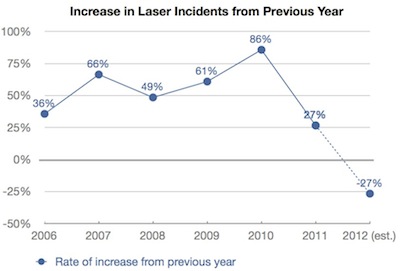
The rate of increase dropped 59% in 2011 (from 86.4% to 27%). If there is another 59% drop in 2012, (dashed line), then there would be a decrease in laser incidents for the first time, from 3,591 incidents in 2011 to 2,836 incidents projected for 2012.
Click to read more...
South Africa: 70 incidents in 2011, including a go-around; no arrests
The majority of South African incidents occurred in Cape Town, with other reports at OR Tambo, Wonderboom in Pretoria, and Lanseria International. In an incident in Lanseria, “two pilots were blinded so badly that after landing they couldn’t see the man who signaled where to park the plane” according to News24.com.
There were no persons arrested during 2011 for aiming a laser at aircraft. Over all years, there have only been two incidents resulting in arrests (as of January 11 2012):
- Around January 7-8 2012, three persons were arrested for pointing green laser beams at helicopters using the Bloemfontein civil and Air Force airports.
- During the 2010 World Cup, a man temporarily blinded a helicopter pilot in Durban
A Civil Aviation Authority spokesperson said “It is a serious hazard to point laser lights at aircraft.” The maximum penalty for an offense is a “hefty fine and up to 30 years in jail.”
The general manager of the Air Line Pilots Association of South Africa said ALPA-SA members were reporting increasing numbers of incidents where “sudden and intense bursts of light [are] deliberately shone at aircraft…”
From The New Age and DefenceWeb
Commentary from LaserPointerSafety.com: The figure of 70 incidents reported to ATNS in 2011 is probably low. A May 5 2011 news story quoted ALPA-SA as saying they receive between 10 and 12 complaints from pilots every week. That would result in 520 to 624 laser illuminations per year. Also, the 70-incident figure may be a misunderstanding or misquote. A news story from March 2011 quotes ALPA-SA as saying there were 70 incidents in the 10 months from April 1 2010 through February 28 2011; see News24.com.
.
Wales: Eight people convicted of laser offences thus far in 2011
A spokesperson noted that several of the arrests involved young people. He said, “We’re hoping parents will see this message so they can remind their children, if they have access to laser pens, not to use them irresponsibly.”
According to the news story, the maximum penalty for recklessly or negligently acting in a manner likely to endanger an aircraft is a fine up to £5,000, and/or five years imprisonment.
From NewsWales. One LaserPointerSafety.com news item about a 2011 Wales conviction is here.
US: ALPA holds major D.C. conference on the threat of laser illuminations
Speakers generally agreed on the nature and scope of lasers as a threat to air safety. They also offered similar solutions, including educating the public to not misuse lasers, prosecuting those who do, training pilots on how to "recognize and recover" from incidents, increasing the number of reports from pilots and the public, and restricting laser pointer availability.
The ALPA conference made news primarily for the announcement of a new FAA web page, which can be reached via www.faa.gov/go/laserinfo. FAA Administrator Randy Babbitt told the ALPA attendees that the web page -- erroneously described as a "website" in many media accounts -- would centralize the agency's information on laser/aviation safety. The page includes email addresses where pilots, air traffic control and the public can report laser incidents (see separate story about the FAA web page).
Babbitt also said that the FAA currently has filed 18 civil cases against individuals who aimed lasers at aircraft. There is a maximum $11,000 fine in each case.
Other speakers gave updates and information in their areas of expertise.Click to read more...
US: FAA urges pilots, public to report incidents on new webpage
- Reporting Laser Incidents: How to report an incident, for pilots, air traffic control officials, and the general public
- U.S. Laser Incidents by Year: A simple table listing incidents each year since 2005
- Laser Events and Civil Penalties: Press releases about the number of incidents in 2010 and about the June 2011 decision to impose civil fines of up to $11,000. Also, the legal interpretation justifying imposition of the fines.
- Hazards of Laser Illumination: Links to background information for pilots, and two studies of the issue by FAA’s Civil Aerospace Medical Institute
- Planning Light Shows and Other Outdoor Laser Operations: Information and forms for persons planning to use lasers outdoors
Below is the FAA press release announcing the web page:Click to read more...
UK: Heathrow laser incidents almost triple
From BBC News
Europe: 4,266 laser incidents; harmonized criminal laws sought
In 2008, there were 1,048 European incidents.
A Eurocontrol safety expert said “Preventing and mitigating the current problem requires a harmonized approach throughout Europe. We need the full involvement of regulators, judicial authorities, police, airlines and their associations, air navigation service providers, laser manufacturers who must understand how serious the problem is, as well as research institutes.”
Most European countries do not have specific laws against aiming lasers at aircraft. Eurocontrol stated they should be subject to the same restrictions as firearms, covering the purchase, transportation and use of lasers.
German politician Volker Kauder said that high-powered lasers should be treated as weapons under the Geman Arms Act.
From the Washington Post
US: Orlando Sentinel runs article on laser hazards
From the Orlando Sentinel
Russia: "Dragging its feet" on laser incidents
US: Laser beams usually are not tracking aircraft; most do not enter cockpit windows
The analysis was done by Rockwell Laser Industries (RLI). They examined 6,903 incidents in FAA’s database, dating from 2004 to mid-March 2011.The cockpit was illuminated only in about 1,875 incidents (27%). Of these, the exposure appeared intentional in about 350 incidents (19% of the cockpit illuminations; 5% of all illuminations). “Intentional” was defined as multiple beam exposures or the beam tracking the aircraft.
There were about 100 incidents (1.5% of all incidents) reported eye effects or injuries to the eyes. (A separate analysis by LaserPointerSafety.com shows that the vast majority of eye effect/injury reports are of minor, temporary effects. There are a few claims of eye injuries, and a very few confirmed claims of retinal injury.)
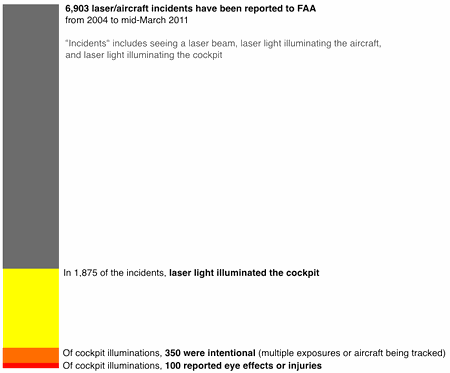
The RLI analysis was done by Kevin Donnelly, and was supervised and presented in August 2011 by RLI president Bill Ertle. Rockwell Laser Industries is a pioneer in providing services and products related to lasers and laser safety.
UK: 270% rise in Surrey-area laser pen incidents
A spokesperson pledged to “deal robustly with any incident involving laser light whether it is an assault on another member of the public or a device being pointed at a vehicle. Laser pen owners should also be aware that Surrey Police’s collision investigation unit can pursue a manslaughter charge if it is found that a fatal or life changing injury collision is due to the use of a laser light. All offences have a power of arrest and could result in a term of imprisonment.”
Police are especially concerned about aircraft illuminations in East Surrey, near Gatwick Airport.
From Elmbridge Today, BBC News, and Redhill and Reigate Life. A list of laser pen offences, compiled by the Surrey police, is here.
Russia: UPDATED - Laser "blindings" increase
On June 8, a pilot was blinded by a laser pointer while landing a Boeing passenger plane in the southern city of Rostov-on-Don, but managed to land safely. The beam came from the area of a local market.
Earlier in the week a pilot of an Airbus A320 plane was blinded by a laser light during landing at the same airport
From RIA Novosti. In addition, Pravda carried a story with some additional details. See also other LaserPointerSafety.com stories about Russian aviation incidents and laser statistics.
UPDATED - June 24 2011: The German news agency DPA reported that these attacks, and additional ones in June in Rostov-on-Don, are the result of Islamist insurgents in the Caucasus region. See this story for details and sources.
UPDATE 2 - July 5 2011: A spokesman for the Federal Air Transport Agency said there have been more than 50 cases of “laser hooliganism” thus far this year in Russia, according to Bloomberg.
Canada: Pilots want lasing to be a criminal offense
Currently, violations of the Aeronautics Act can lead to fines of up to $100,000 and up to five years in prison. Despite this, laser illuminations continue to occur.
In 2010, there were 182 reported laser pointing incidents. Ontario had the highest number, 69, followed by Quebec with 53 incidents. Transport Canada and the ACPA said this was due to increased reporting, copycat laser use, and the increased availability of laser pens and pointers.
“This is just like shooting a gun at an airplane around [an] airport,” according to Nick Stoss, formerly with the Transportation Safety Board.
From Global Winnipeg
South Africa: Incidents are increasing; pilots express concern
A representative of the Civil Aviation Authority said that laser misuse violates two sections of the Civil Aviation Regulations, and can be punished with a fine and/or imprisonment of up to 10 years. (There was an arrest in 2010 during the World Cup, when 35-year-old Yusuf Ebrahim temporarily blinded a helicopter pilot.) The CAA representative said the Authority would consider new standards or regulations if they were recommended by the International Civil Aviation Organization.
To report a laser illumination incident in South Africa, CAA said to email information to cahrs@caa.co.za or fax it to 011 545 1453.
From Independent OnLine Scitech. An IOL story about Yusuf Ebrahim’s first court appearance is here.Click to read more...
South Africa: Up to 12 incidents per week, say pilots
ALPA-SA is calling for public education and a ban on handheld laser sales. According to the organization, there was a temporary drop in the number of incidents after media reports earlier in 2011, but the incidents are now on the rise again.
A spokesperson for the Civil Aviation Authority said “a few cases” had been reported thus far in 2011. He added that if the International Civil Aviation Organization introduced new regulations, the CAA would “definitely look into implementing it.”
From the Cape Argus
New Zealand: Pilots call for restrictions after 16 incidents to date in 2011
According to NZALPA’s vice president Glen Kenny, “There is no restriction on the sale and distribution of commercial-strength lasers in New Zealand. In Australia they treat Class 3 lasers or higher as a potential weapon."
NZALPA had previously proposed restrictions in New Zealand “two or three years ago” but the organization wanted it given a higher priority. A spokesman for the Ministry of Health’s National Radiation Laboratory said the issue was “still being considered.” He did note that there have been “successful police prosecutions where people had carelessly or deliberately aimed lasers at vehicles or aircraft.”
From the New Zealand Herald
Grenada: Increasing incidents
Violators could be charged with interfering with air crew duties. The Authority is looking for the laser perpetrator(s), and has posted notices in newspapers stating that shining lights at aircraft is “a security offense”. Also, several pilots have filed complaints with the Eastern Caribbean Civil Aviation Authority.
From the Virgin Islands News Online
Switzerland: Incidents double to 80 in 2010
From GenevaLunch.com
Italy: 479 incidents in 2010
From L’Eco di Bergamo (in Italian)
Germany: 273 (or 388) incidents in 2010; call for ban on pointers
He recommended fast action. He discussed a European import ban, as well as classifying lasers as a weapon, and prohibiting private possession of Class 3 and Class 4 lasers. He said, “I call on the competent authorities to submit to the problem of dangerous laser fast red tape as possible solutions, before something happens and people get hurt.”
The pilot’s union Vereinigung Cockpit said an import ban is not sufficient, because customs checks are difficult. Cockpit board member Joerg Handwerg said "Although lasers may not be sold in shops with a capacity of more than one milliwatt in Germany, but you get the devices in the Internet.” The group wants to prohibit the possession of equipment for private individuals.
Original articles (in German) from Rettung Magazine, Fluege.de News, and Heute.de.
*NOTE: An April 23 2011 article from N-TV.de says there were 388 “attacks with laser pointers at pilots” in 2010. This is according to the German air traffic control agency, DFS. The article had no additional information that might account for the discrepancy with the 273 incidents in 2010 that is quoted above.
US: 2,836 laser events reported in 2010; FAA expresses concern
FAA spokesperson Laura Brown told LaserPointerSafety.com that in roughly 90% of the reports, the cockpit and/or pilot was illuminated by the laser. (In the other 10%, a beam was seen outside the aircraft but light did not enter the cockpit.) As far as injury reports, Brown said that these were “fairly rare”.
The FAA’s press release listed the top 20 affected airports, with Los Angeles International Airport topping the chart with 102 “laser events” in 2010. LaserPointerSafety.com has further analyzed the airport data to show that for these top 20 airports, an event occurred once every 7,000 takeoffs and and landings; the analysis is here.
According to the press release, “[t]he increase in reports is likely due to a number of factors, including the availability of inexpensive laser devices on the Internet; higher power levels that enable lasers to hit aircraft at higher altitudes; increased pilot reporting of laser strikes; and the introduction of green lasers, which are more easily seen than red lasers.”
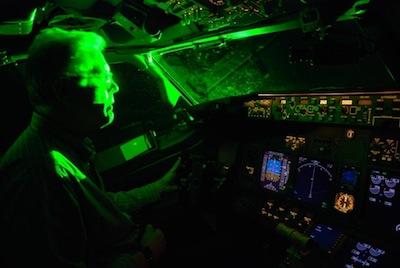
The FAA released the photo above, illustrating what a direct laser illumination of a cockpit can look like.
To read the full FAA press release, and see the list of 20 most affected airports, click the “Read More...” text below. In addition, updated statistics for the current year are here.
US: FAA issues study of 2,492 laser events from 2004 to 2008
The study is entitled “The Illumination of Aircraft at Altitude by Laser Beams: A 5-Year Study Period (2004-2008)”. The FAA’s abstract is here; and the full 12-page report in PDF format is here.
Canada: 2010 laser/aircraft incidents almost double 2009
Transport Canada also released figures on incidents in Alberta, after an Aug. 16 arrest in Calgary. So far in 2010, there have been 11 reports of laser beams aimed at or hitting aircraft, compared with nine in all of 2009.
From the Calgary Herald
UK: Laser beam air attacks on rise
Some of the more interesting quotes:
- Pilot Kevin Medlock: "It's so brilliant, it takes away part of your vision for a few minutes at least. We fly an aircraft, 148 passengers, making an approach to landing at 170 miles per hour. The consequences of someone shining a laser in my eyes at that stage of flight isn't worth bearing the consequences." Medlock was hit by laser beams twice in one month.
- "What's worrying experts is the rate at which the problem is growing:" 29 U.K. attacks in 2007, 206 attacks in 2008, and 461 in 2009 (through September).
- (video of teen walking into court) "This man said he was trying to see how far his laser could reach. Dean Bottomley was sent to jail."
- Captain Bob Jones, U.K. Civil Aviation Authority: "We're trying to raise the awareness of the general public, rather than worry or frighten them."
From BBC News
Canada: List of many Canadian incidents
- A Cessna pilot flying over downtown Vancouver on May 25 2009, who had "flash blindness for a few seconds"
- More than two dozen reports of lasers being directed at airplanes in British Columbia since 2000.
- About 100 incidents of laser beams pointed at aircraft across Canada, since 2005.
- A Cessna pilot in June 2008 who "experienced slight vision impairment, and for safety reasons requested a wide left-hand 270-degree turn ... for brightness recovery and a stabilized approach".
- A helicopter co-pilot in November 2007 who looked at a laser and "was experiencing sun spots [sic] in her vision, which continued for the remainder of the flight."
- At least three incidents, two in June and one in November 2008, where Royal Canadian Mounted Police pilots were targeted.
- In July 2008, a Calgary man was fined $1000 after pleading guilty to shining a laser at an Air Canada flight.
Culbert's story also lists the first attack LaserPointerSafety.com is aware of on a blimp: "A green light was pointed into the cockpit of a blimp over Victoria's [B.C.] shoreline in October 2005. [CADORS reported that] 'several laser attempts were made and the pilot said he was affected twice. Quite aggressive attempts were made by the person using the laser light according to the pilot.' "
Ireland: Pilots call for pointer ban
The Irish Aviation Authority has said ten incidents have occurred since September 2008. Aer Lingus airlines said six of their flights were targeted “in recent months”
From RTE News. The article also has links to two RealAudio video reports on the pilots’ call for restrictions, and on the Dublin incidents.
Canada: Pilots call for better labeling; tougher penalties
According to Transport Canada, there have already been 56 occurrences this year [2008] compared with 21 in 2007. The department has recorded a total of 83 since 2005.
"The increase in the number of laser events that are occurring in Canada and around the world are alarming to us," said Capt. Barry Wiszniowski of the Air Canada Pilots Association. "The laser events that are occurring are probably one of the greatest safety concerns that we have right now as a profession."
Wiszniowski said the industry is calling on laser manufacturers to develop labeling that will contain warnings similar to those on tobacco products.
He is also encouraging the courts to issue stiffer penalties to offenders.
Many more details at Metronews
Canada: Number of pilots blinded by laser pointers increases
As of October 17 this year, Transport Canada had received 46 reports of incidents involving "directed bright lights" being shone at a civilian airplane's cockpit from the ground, says Jean Riverin, a spokesman for the national regulator. This compares with 21 reports for all of 2007, and only three each for 2006 and 2005. When Transport Canada receives a complaint, adds Riverin, "we notify the RCMP or local police, who coordinates the investigation."
It is an offense under section 74.1 of the federal Aeronautics Act to "engage in any behaviour that endangers the safety or security of an aircraft in flight." A violation of the act can lead to a maximum penalty of $100,000 or five years imprisonment following a conviction, or to $25,000 or 18 months imprisonment following a summary conviction.
Click to read more...
UK: Growing concern over laser pointers
The pilot, who was over Stockport at the time, was temporarily blinded. Unable to read his instruments, he had to make dangerous emergency manoeuvres.
This case highlights a growing concern about the inappropriate use of more powerful green laser pens or pointers.
Britain's largest pilots union BALPA has recently warned of a major air disaster unless action is taken.
Click to read more...
Australia - 1200 illegal pointers seized
"Under the new Customs regulations (introduced July 1), hand-held laser pointers with an emission level greater than one milliwatt (1mW) are prohibited, unless prior written permission has been granted," Minister for Home Affairs Bob Debus said.
Click to read more...
Australia: Pointers to be banned in the ACT
“These amendments will make it an offense to possess or use powerful handheld laser pointers and are consistent with other jurisdictions that have moved to prohibit these items,” Corbell said in a statement. “Police will have the power to apprehend and prosecute a person who uses a laser pointer to target aircraft or vehicles.
Click to read more...
Australia: Lasers banned at football game; jail possible
The league has vowed to work with police and venues to crack down on the problem following at least two incidents in Friday night's Richmond-Collingwood clash.
"The AFL will work with police and our venues to ban anyone caught using laser lights to distract players during the course of a match," said league operations manager Adrian Anderson.
"It's unacceptable for players in a contact sport having something shine in their eyes while playing the game.
A sharp jump in the number of lasers aimed into aircraft cockpits has sparked new laws to allow offenders to be jailed.
The draft laws will be put before the Senate today. The legislation comes as Transport Minister Mark Vaile reported there had been 170 laser incidents in 2007 and the dangerous practice was happening more often.
Click to read more...
